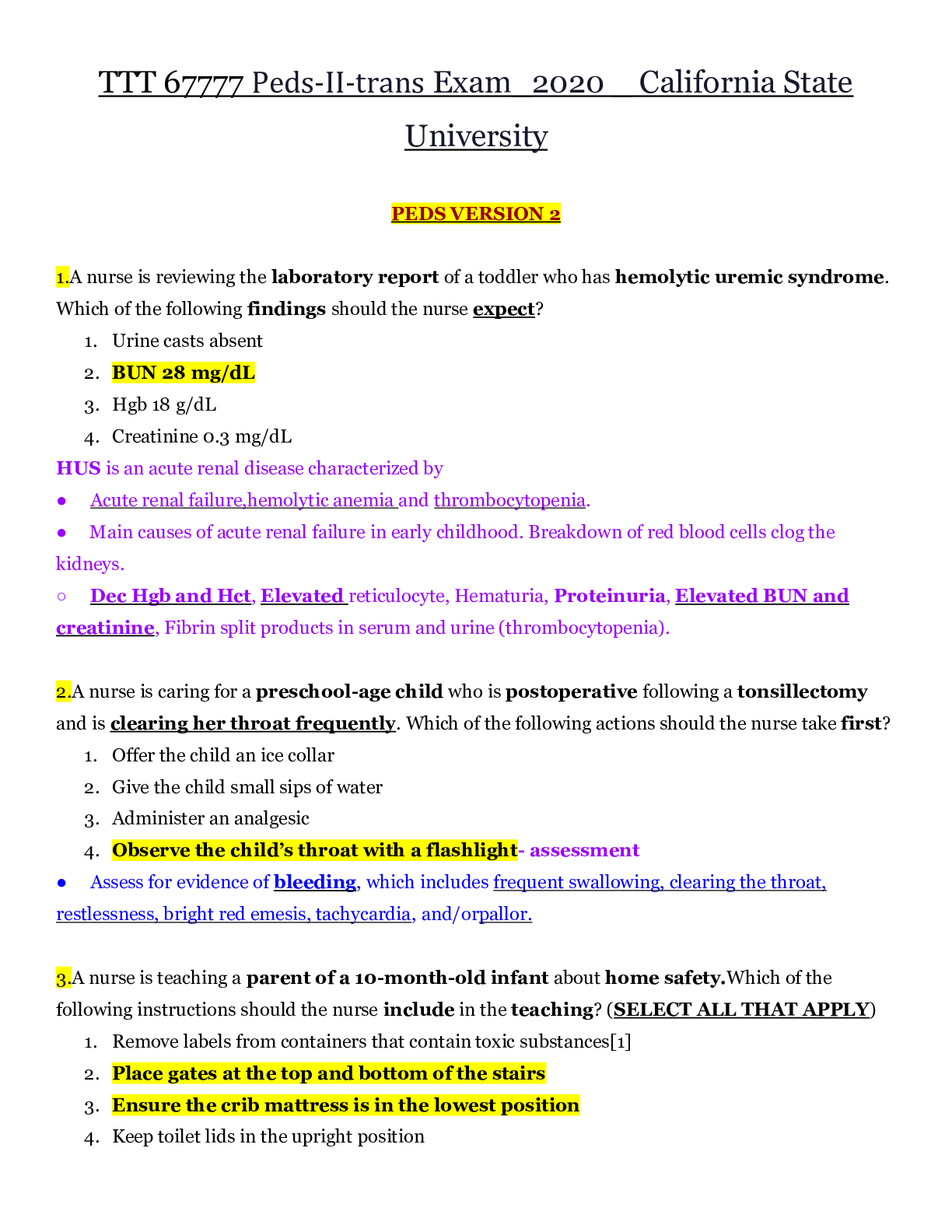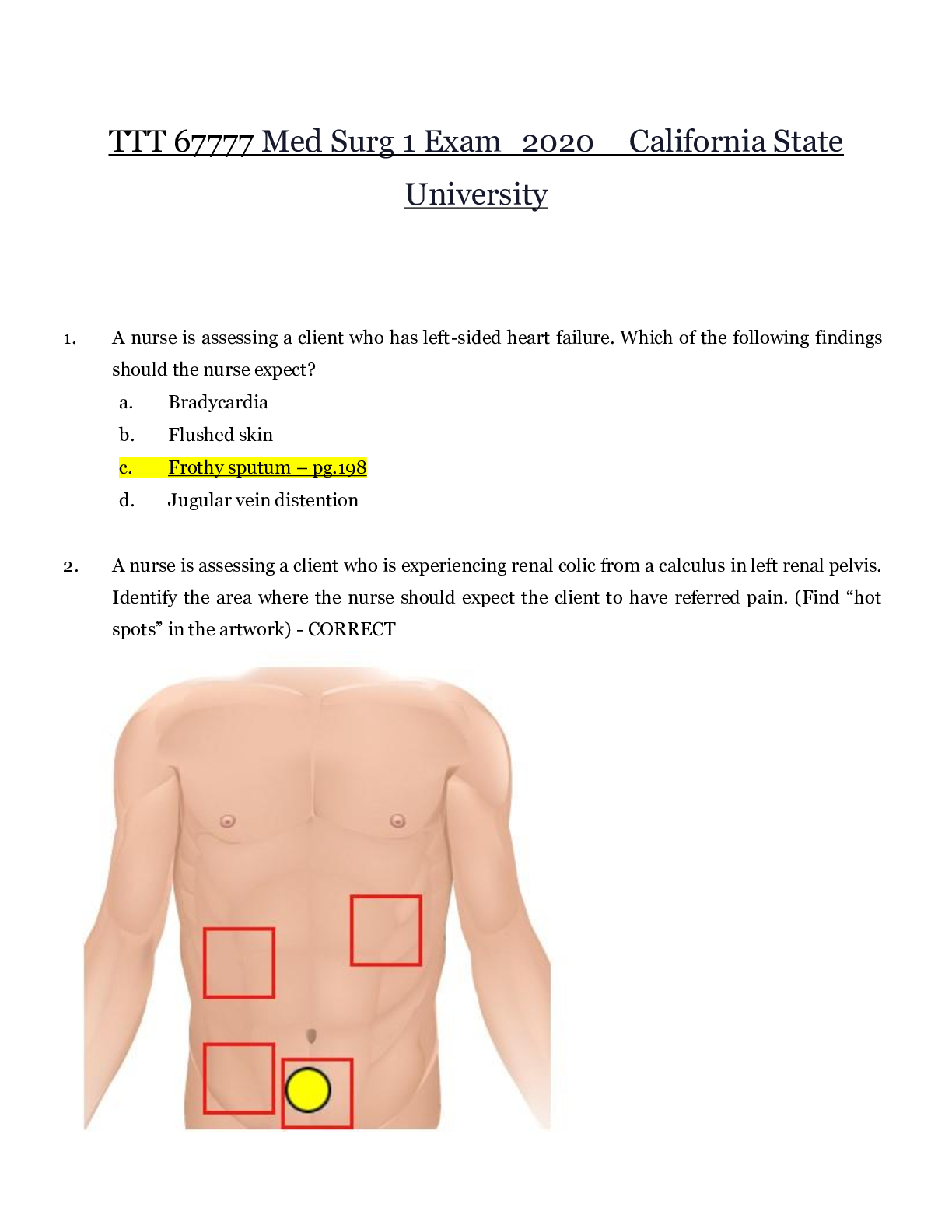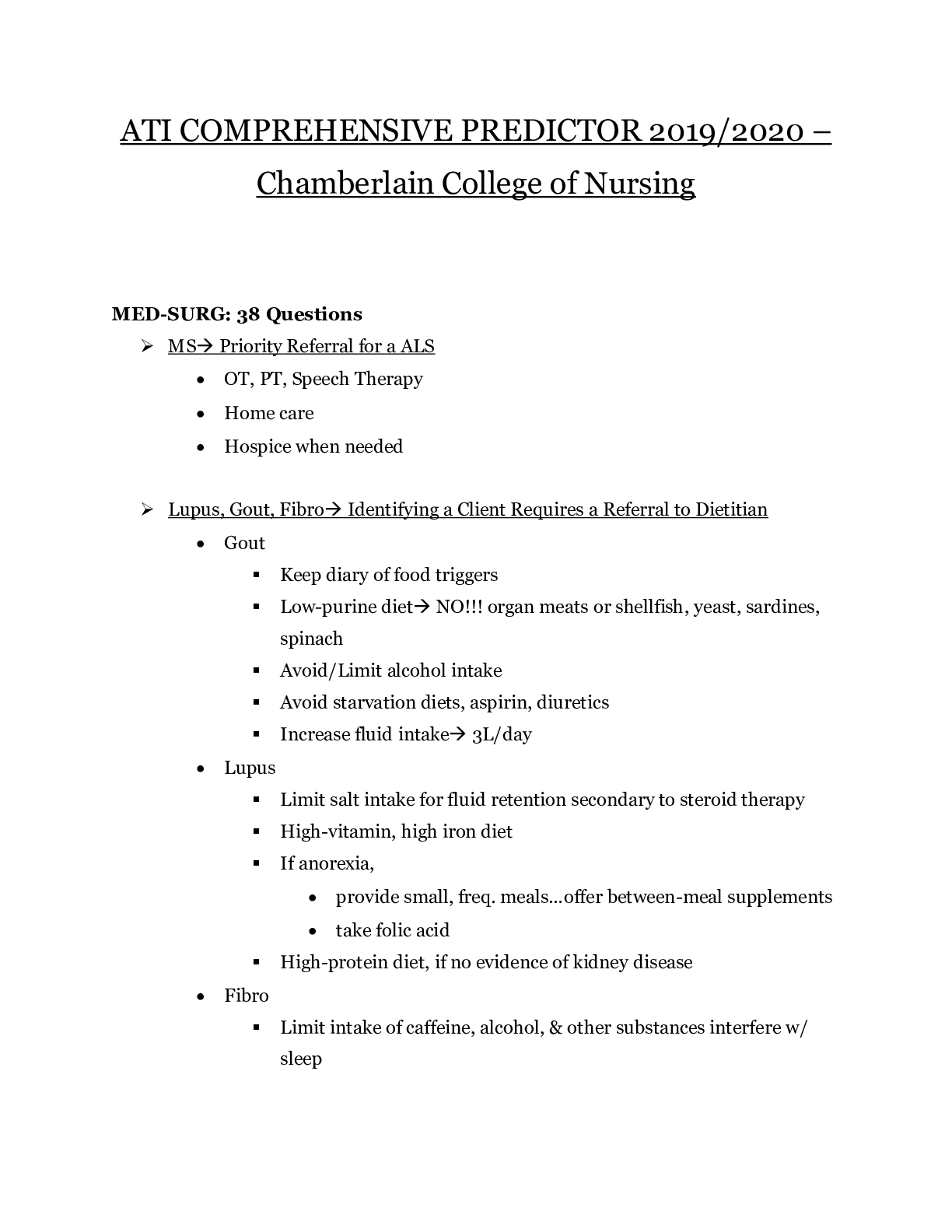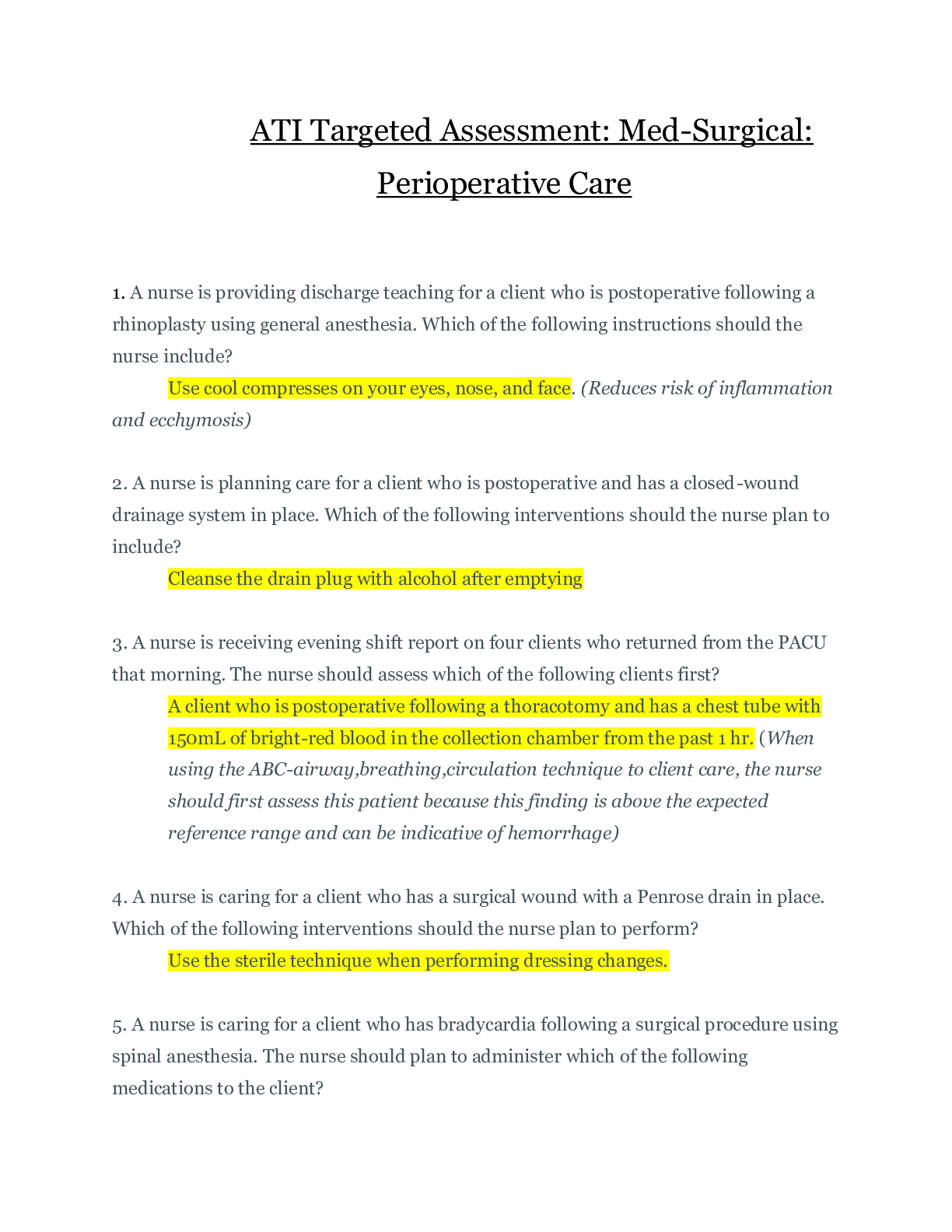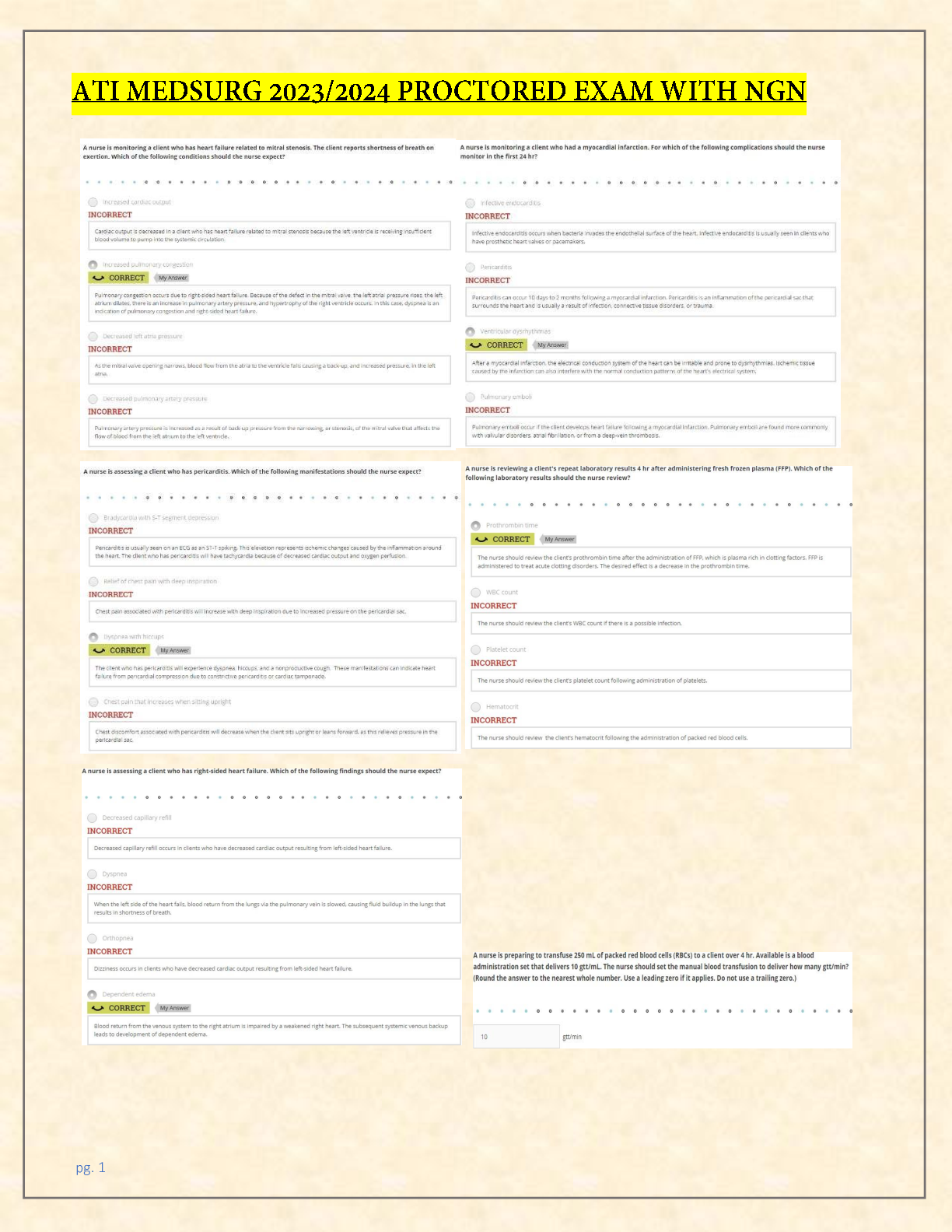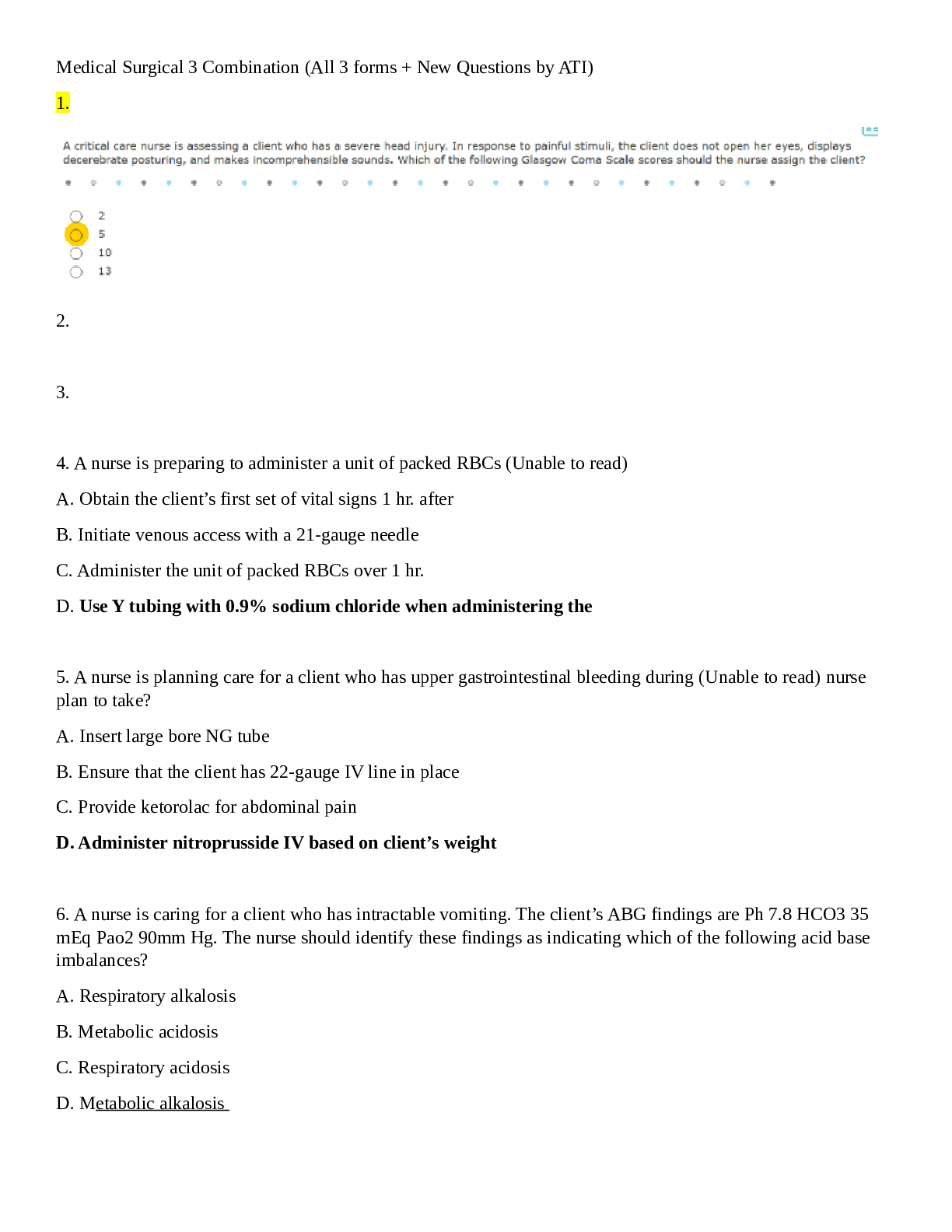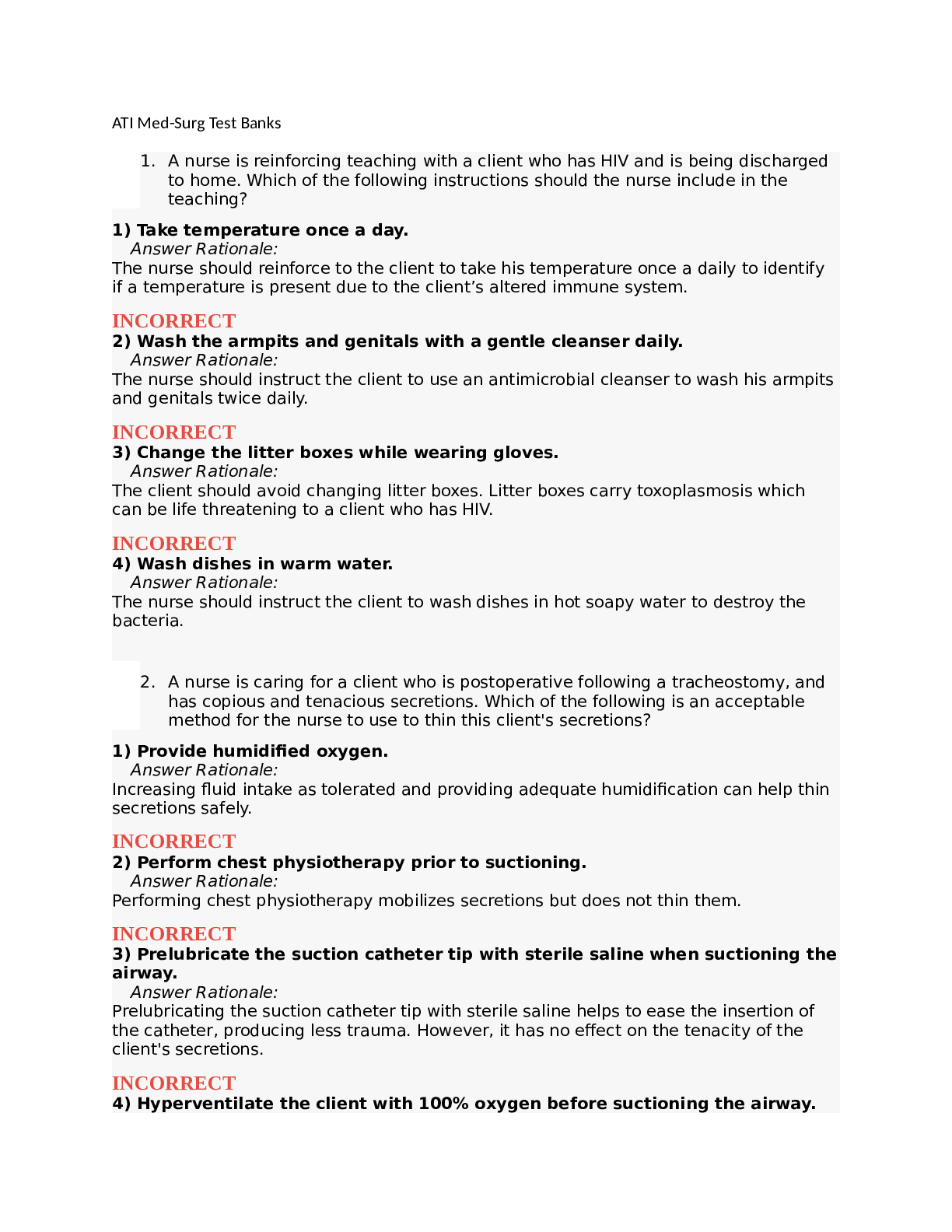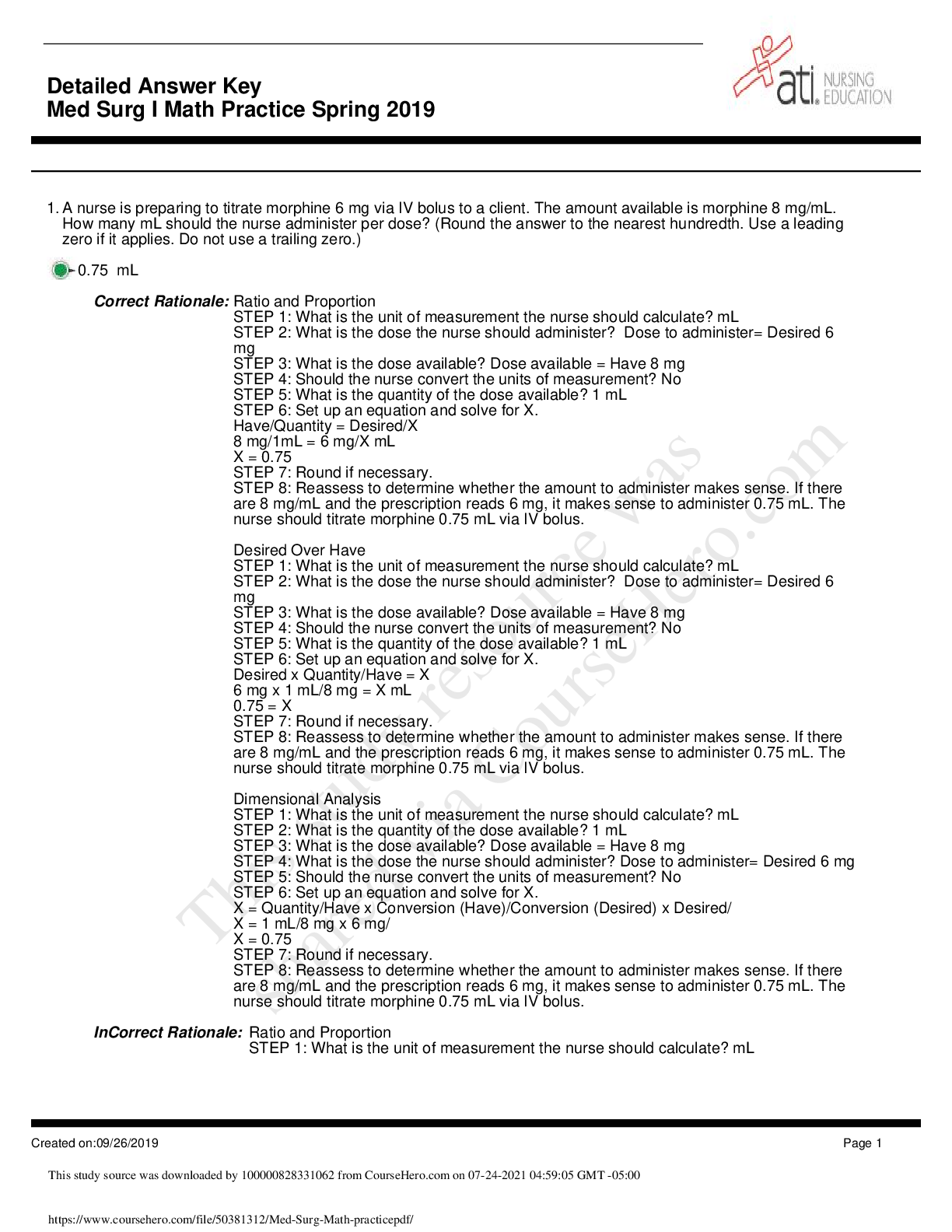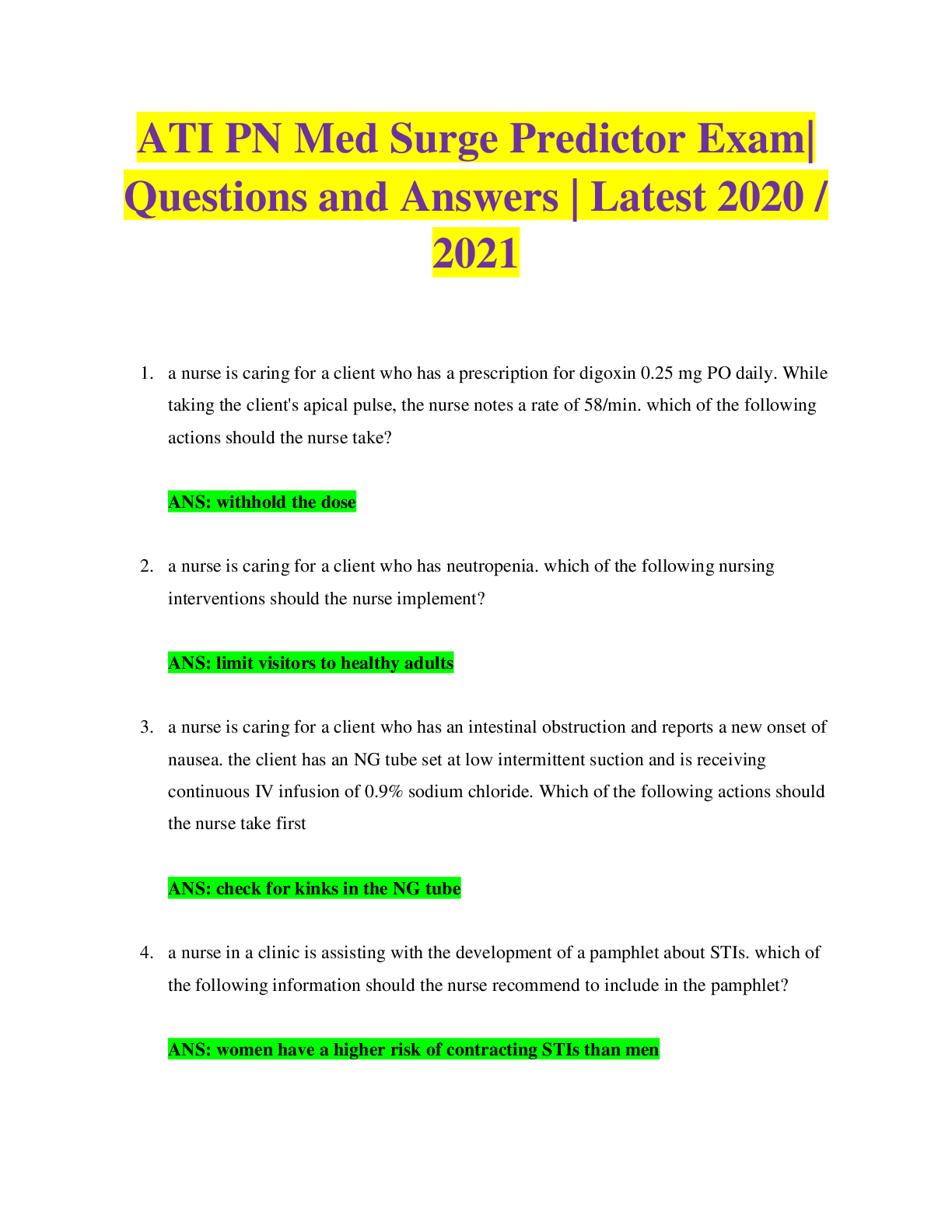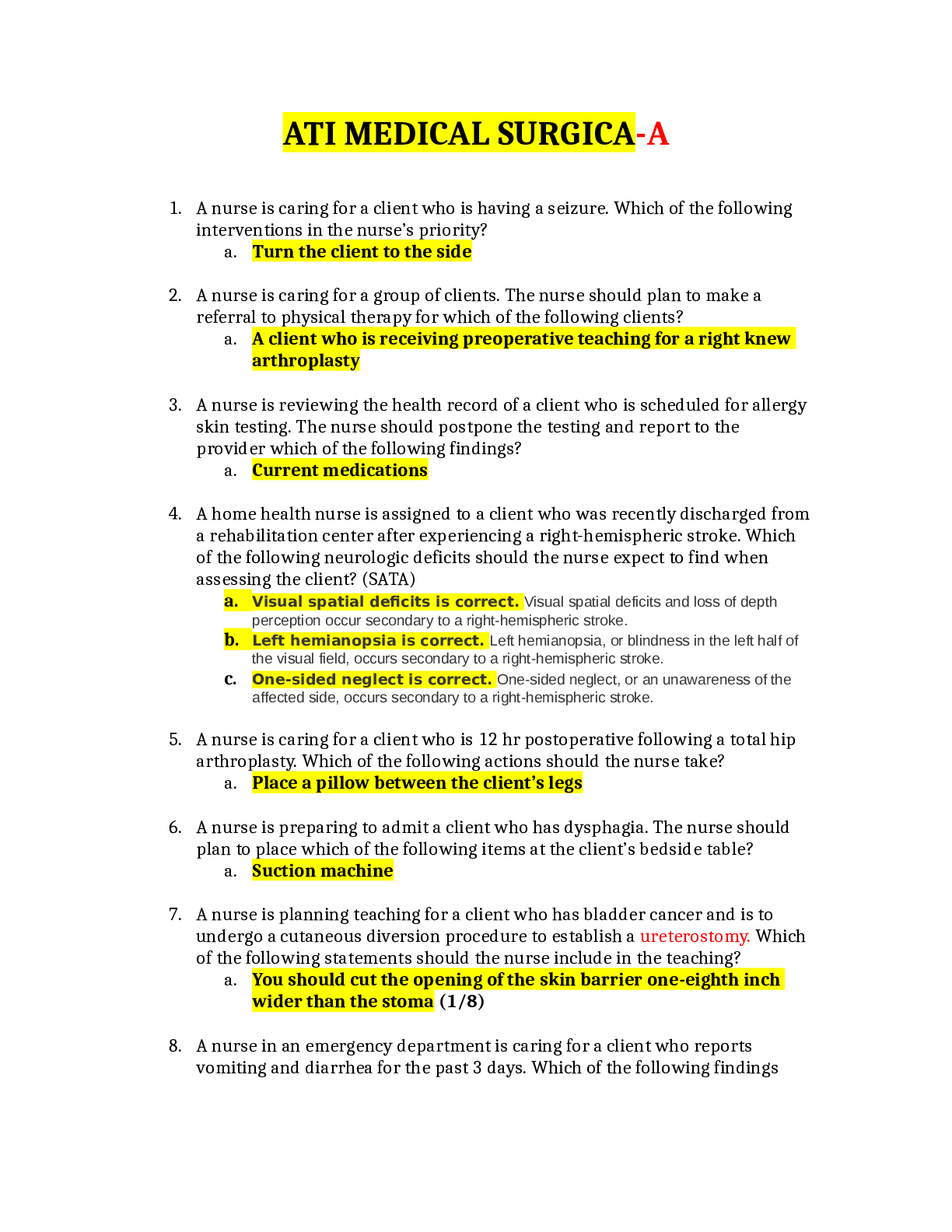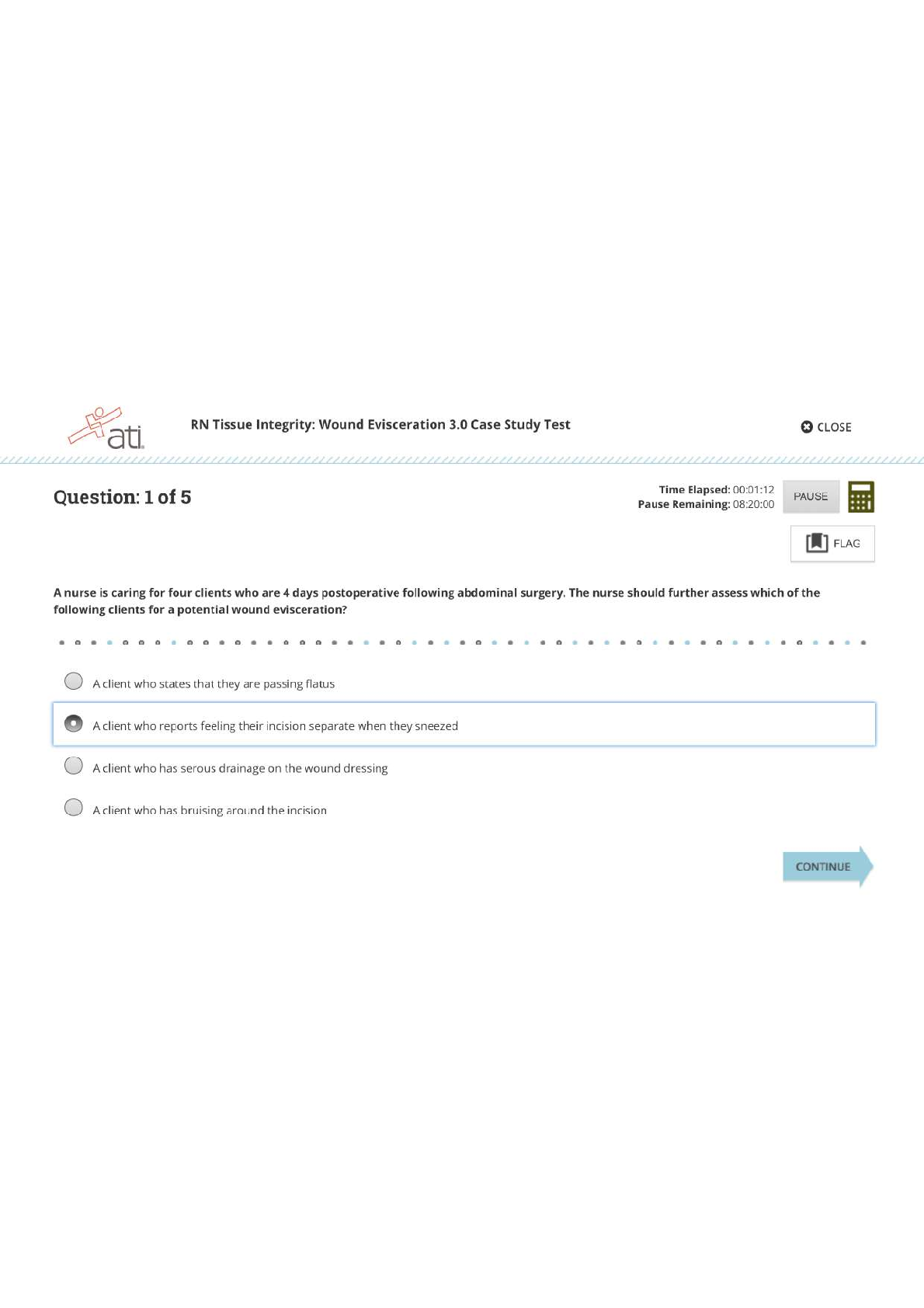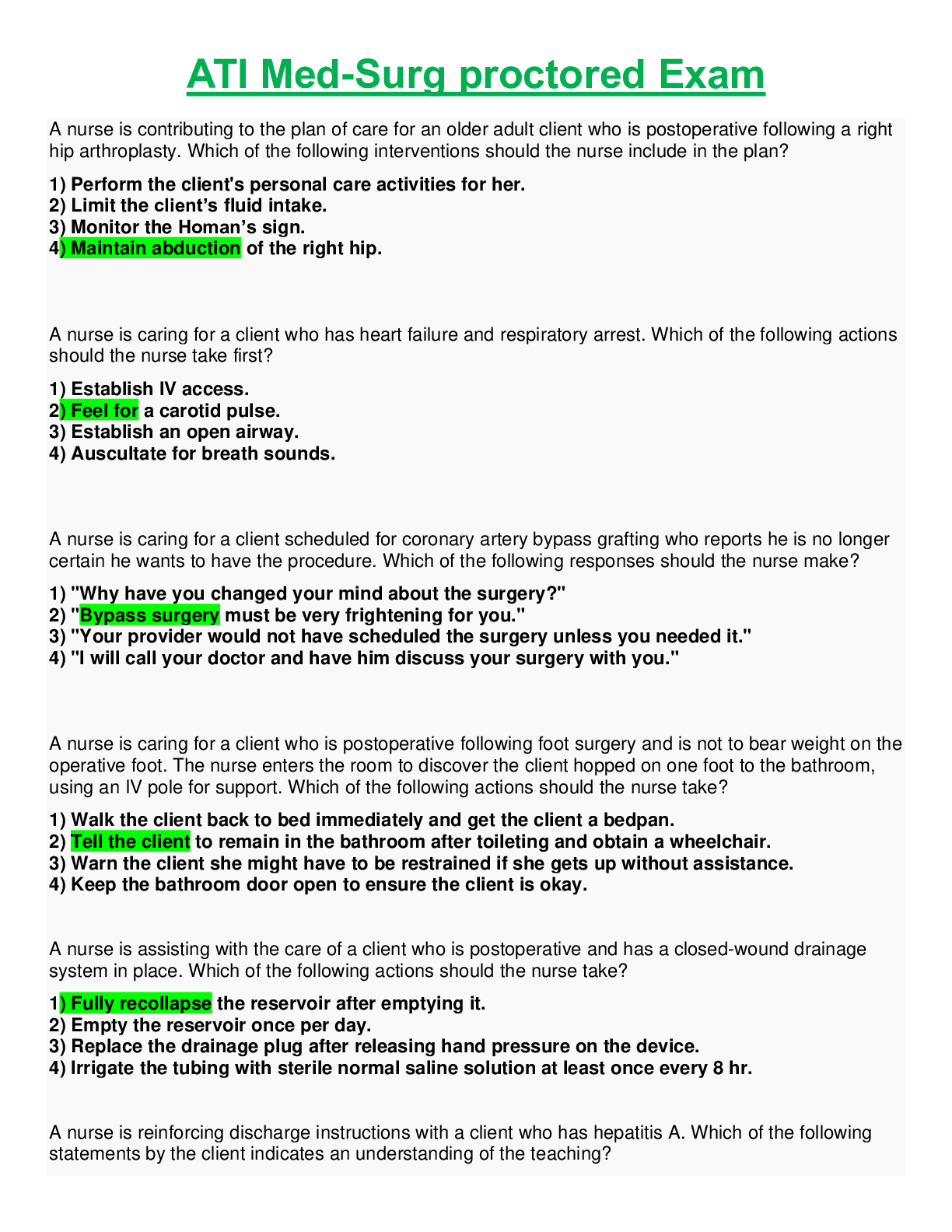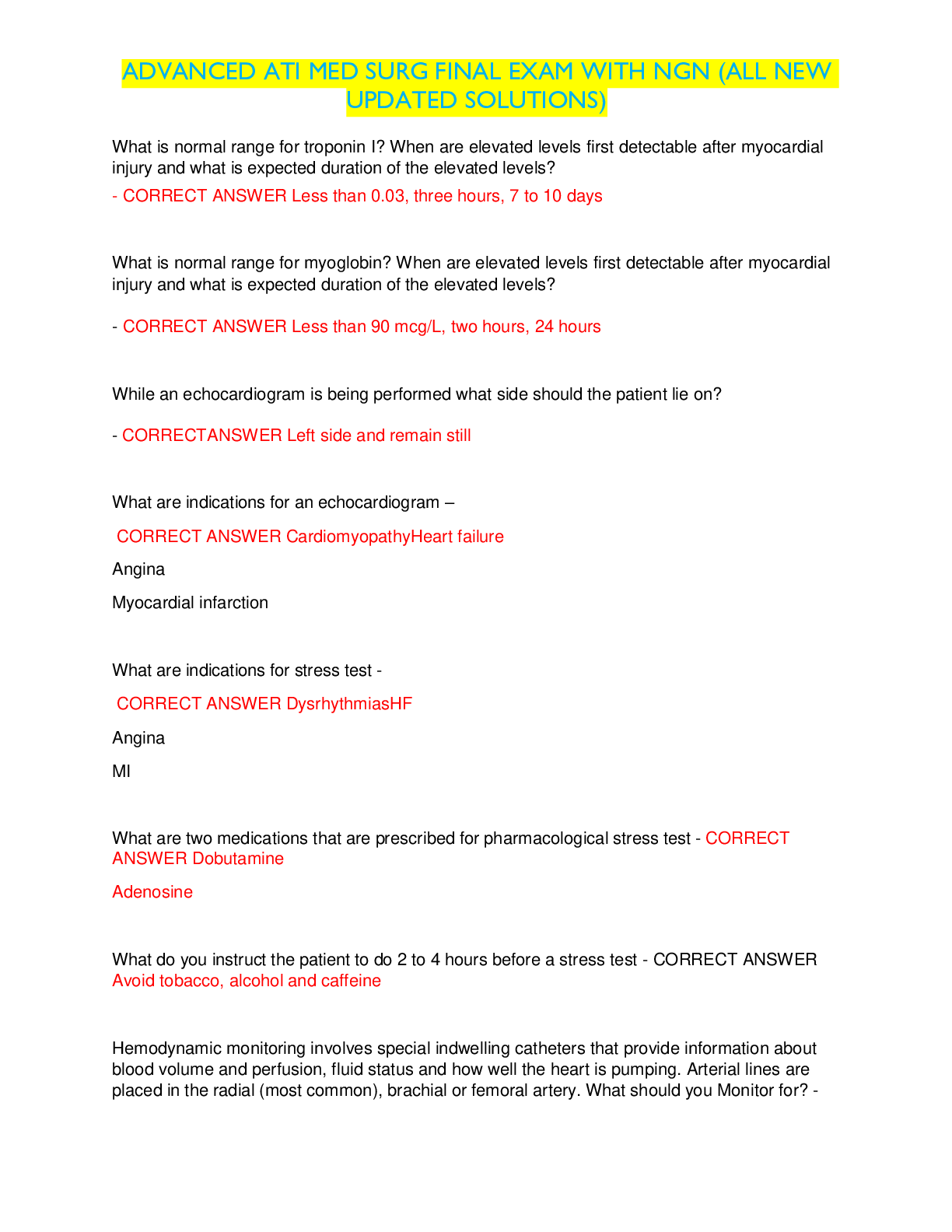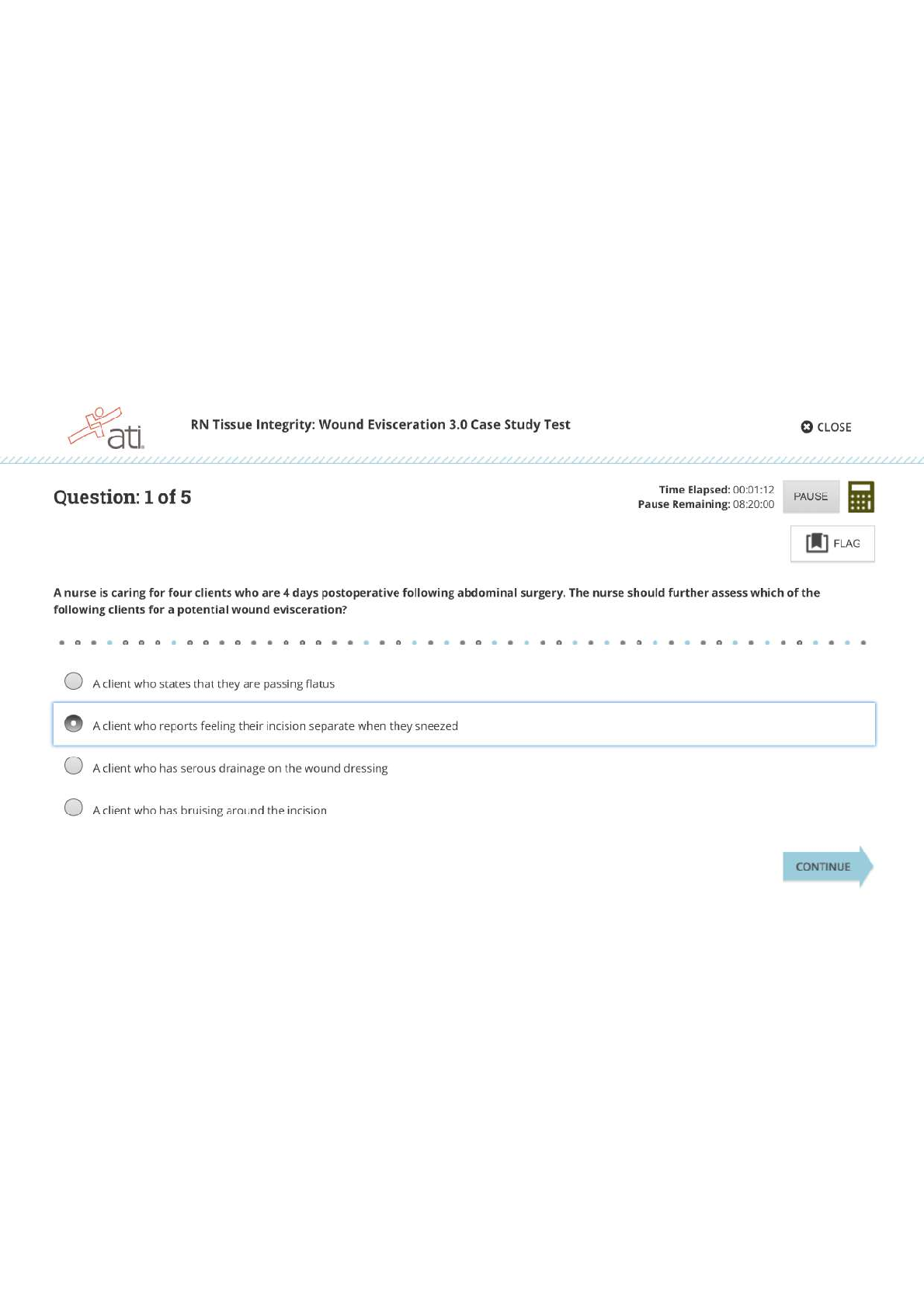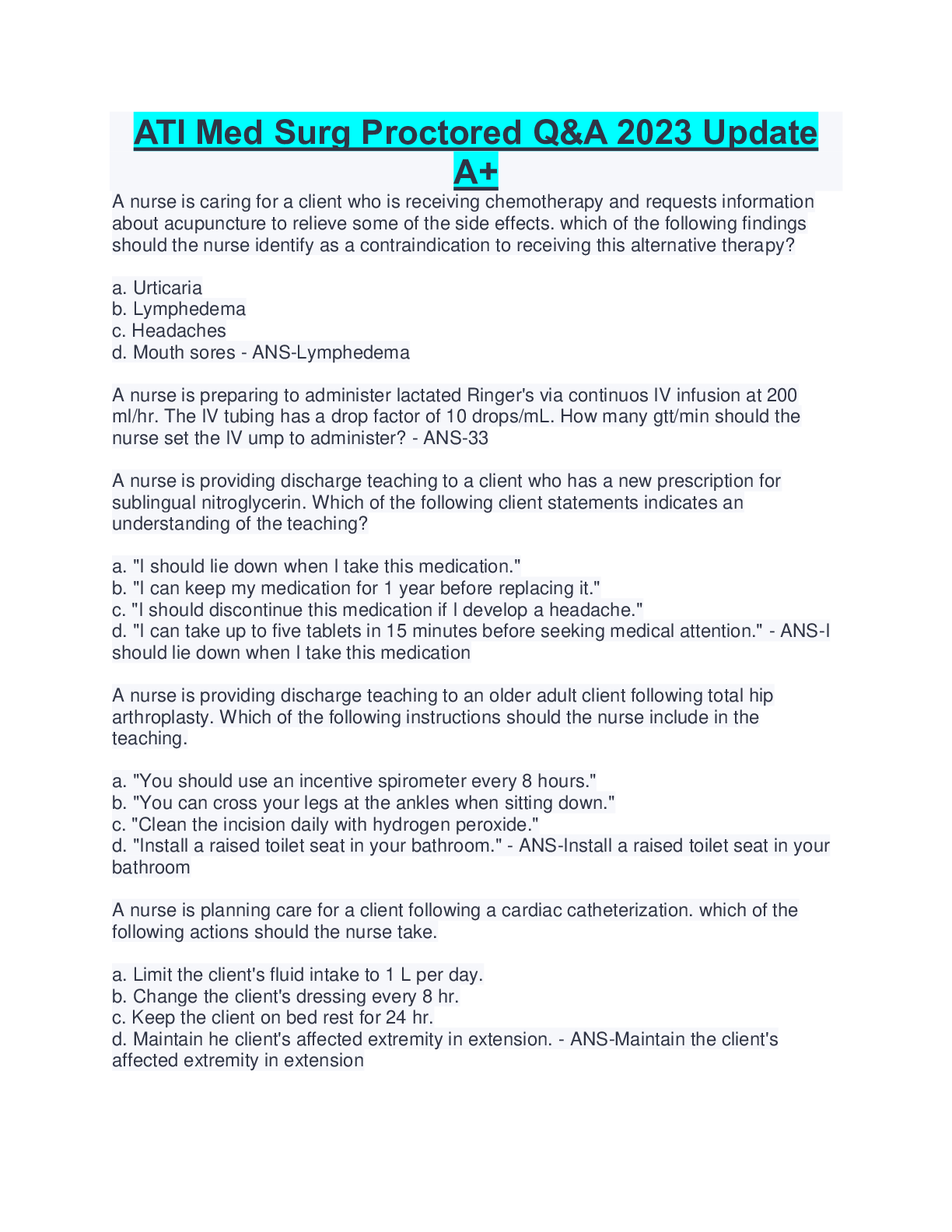*NURSING > ATI MEDICAL SURGICAL > ATI Med-Surg Part B (All)
ATI Med-Surg Part B
Document Content and Description Below
ATI Med - Surg part B LATEST – Chamberlain College of Nursing MED-SURG PART B 1. A nurse is reinforcing teaching with an older adult client who has osteoporosis. Which of the following instr... uctions should the nurse in the teaching? a) "Place throw rugs on wooden floors at home." b) "Supplement your diet with vitamin E." c) "Swim laps for 20 minutes twice per week." d) "Take calcium supplements with meals." (The nurse should instruct the client to take calcium carbonate supplements with or following meals to increase absorption and effectiveness.) 2. A nurse is reviewing the medication record of a client who is taking digoxin. Which of the following medications should the nurse identify as increasing the risk for the client to develop digoxin toxicity? a) Potassium chloride b) Famotidine c) Levothyroxine d) Furosemide (The nurse should identify that loop diuretics, such as furosemide, increase the urinary excretion of potassium, which can lead to hypokalemia. Hypokalemia increases the risk for the development of digoxin toxicity.) 3. A nurse is reinforcing teaching about insulin injections with an adult client who weighs 45.4 kg (100 lb.). Which of the following statements by the client indicates an understanding of the teaching? a) "I should insert the needle at a 90-degree angle." b) "I should give my shot in my belly tissue." (Clients who have low body weights can have very little subcutaneous tissue. Therefore, the nurse should instruct the client to administer the medication in the upper abdomen for proper absorption.) c) "I will pull back on the syringe plunger to look for blood before I push the medication in." d) "I will use the side of my hand to pull my skin to the side prior to administering the insulin." 4. A nurse is reinforcing discharge teaching for a client who had a mechanical mitral valve replacement. Which of the following statements by the client indicates an understanding of the teaching? a) "I will notify my dentist about this procedure." (The nurse should instruct the client to notify his dentist about the mechanical mitral valve replacement before any procedures so antibiotic therapy can be initiated to reduce the risk of endocardial infection.) b) "I will take an enteric-coated aspirin daily." c) "I will use a firm-bristled toothbrush." d) "I will weigh myself once a week." 5. A nurse is reviewing the medical record for an older adult client who is experiencing nausea and vomiting. Based on the client data, which of the following actions should the nurse take? (Click on the “Exhibit” button for additional client information. There are three tabs that contain separate categories of data.) View the Exhibit Exhibit 1 Exhibit 2 Exhibit 3 Diagnosis Results Sodium 142 mEq/ Potassium 4.2 mEq/L BUN 36 mg/dL Creatinine 1.4 mg/dL Nurses’ Notes 1200: Alert and oriented x3 Lungs clear to auscultation Decreased skin turgor Dry mucous membranes Graphic Record Temperature 0800: 37.7° C (99.9° F) 1200: 37.2° C (99.0° F) Pulse 0800: 96/min 1200:105/min Respiratory rate 0800: 18/min 1200: 20/min Blood pressure 0800; 118/62 mmHg 1200: 104/65 mm Hg a) Encourage the client to ambulate. b) Administer an antipyretic medication. c) Notify the charge nurse of the client's BUN level (The client's BUN level is above the expected reference range of 10 to 20 mg/dL, which indicates dehydration and impaired renal function. The nurse should notify the charge nurse of this finding and anticipate interventions to restore the client's fluid volume.) d) Keep the temperature in the client's room warm. 6. A nurse is providing information regarding transmission-based precautions for a client who has Clostridium difficile to an assistive personnel (AP). Which of the following instructions should the nurse include? (Select all that apply). a) "Provide the client with disposable utensils and dishes for meals." (Clients who have C. difficile require contact precautions, which include using disposable utensils and dishes during meals to prevent exposure to contaminants by others.) b) "Leave blood pressure equipment in the client's room." (When using contact precautions, the health care staff should dedicate equipment to single-client use to prevent transmission of the pathogen.) c) "Clean contaminated surfaces with a bleach solution." (The health care staff should use a bleach solution to clean equipment to prevent transmission of the pathogen.) d) "Use an alcohol-based hand sanitizer after client care." e) "Wear a face mask when in the client's room." 7. A nurse is admitting a client who is suspected having active tuberculosis (TB). Which of the following actions should the nurse take first? (chap. 20) a) Administer antituberculosis medication. b) Institute airborne precautions. (The greatest risk from this client is transmitting TB to staff and other clients. Therefore, the first action the nurse should take is to implement airborne precautions.) c) Obtain sputum cultures. d) Auscultate breath sounds. 8. A nurse is caring for a client who is postoperative and has a Jackson-Pratt drain. Which of the following actions should the nurse take? a) Fill the bulb reservoir with 0.9% sodium chloride. b) Allow the Jackson-Pratt drain to hang freely. c) Cut a slit in a gauze sponge and apply it around the tubing insertion site. d) Compress the bulb reservoir and then close the drainage valve. (The nurse should fully compress the bulb reservoir and then replace the valve plug using aseptic technique to establish suction after emptying or activating a Jackson-Pratt drain.) 9. A nurse is reinforcing teaching with the parent of a toddler who has type I diabetes mellitus and whose prescription has been changed from regular insulin to lispro insulin. Which of the following information should the nurse include in the teaching? a) Lispro is given once a day. b) Lispro should be given before eating. (Lispro insulin should be given around mealtime, within 15 min before or after eating.) c) Lispro cannot be given with other insulin. d) Lispro does not cause hypoglycemia. 10. A nurse is reinforcing teaching with a client who has microcytic anemia and is prescribed a daily iron supplement. The nurse tells the client to consume foods containing vitamin C when taking the supplement to enhance iron absorption. Which of the following client food choices indicates an understanding of the teaching? a) 1 cup cooked brown rice b) 1 cup boiled broccoli (The nurse should determine that choosing boiled broccoli indicates an understanding of the teaching because 1 cup contains 101 mg of vitamin C per serving.) c) 1 cup cottage cheese d) 1 cup cooked kidney beans 11. A nurse is assisting with the development of a plan of care to manage pain for a client who has herpes zoster with lesions on the lower extremities. Which of the following interventions should the nurse include in the plan of care? a) Keep bed linens off of the affected areas. (The nurse should keep bed linens off of the affected areas using a bed cradle, which will relieve pain caused by the linens rubbing against the lesions.) b) Position a heat lamp over the lower extremities. c) Apply warm, moist compresses to the affected areas. d) Initiate droplet isolation precautions. 12. A nurse is reinforcing teaching with a client about increasing dietary fiber. The nurse should recommend which of the following foods as the best source of fiber? a) ½ cup cooked kidney beans (The nurse should recommend kidney beans as the best source of fiber because ½ cup contains 6.5 g of fiber per serving.) b) ½ cup raw cauliflower c) 1 cup cucumber with peel d) 1 cup parboiled brown rice 13. A nurse is assisting in the care of a client who has AIDS-related pneumonia. The client is receiving antibiotic therapy and albuterol nebulizer treatments daily. Which of the following findings should indicate to the nurse that the client’s therapeutic regimen is effective? a) Adventitious lung sounds b) Decrease in exertional dyspnea (A decrease in exertional dyspnea indicates the antibiotics are resolving the infection and the albuterol treatments are facilitating effective ventilation. Therefore, the nurse should evaluate the therapeutic regimen as effective for the client.) c) Respiratory rate of 26/min while sitting in a chair d) Elevation of the head of the bed is required to sleep 14. A nurse is monitoring a client who has a wrist cast and reports intense itching underneath the cast. Which of the following actions should the nurse take? a) Blow cool air into the cast using a blow dryer on a cool setting. (Using a blow dryer on a cool setting to blow cold air into the cast is an effective way to relieve the client's itching without damaging the skin.) b) Obtain a prescription for pregabalin. c) Ask the provider to bivalve the cast. d) Provide the client with a tongue blade to rub the skin under the cast. 15. A nurse is preparing to insert a double-lumen gastric (Salem) sump tube for a client who has peptic disease and has developed gastrointestinal bleeding. Which of the following images indicates the tube that the nurse should select? a. In a double-lumen gastric (Salem) sump tube, the clear portion of the tube allows for aspiration of stomach contents. The blue portion of the tube, or the "pig tail", vents the tube to the atmosphere, which prevents the tube from becoming lodged against the wall of the stomach and protects the stomach from damage. b. This image shows a percutaneous endoscopic gastrostomy (PEG) feeding tube. A provider inserts a PEG feeding tube surgically through the abdomen and into the stomach to allow for longer-term medication administration and tube feedings. c. This image shows a Levin tube. It is a single-lumen nasogastric tube which facilitates gastric decompression. Damage to the gastric mucosa can occur during aspiration of stomach contents with this tube. d. This image shows a Sengstaken-Blakemore tube. The provider prescribes this tube in the treatment of bleeding esophageal varices. 16. A nurse is caring for a client who has just returned to the unit following a bronchoscopy. Which of the following findings should the nurse report to the provider? a) Absent gag reflex b) Blood-tinged mucus c) Diminished breath sounds (Diminished breath sounds might indicate a pneumothorax or laryngeal edema. The nurse should report this finding to the provider for further evaluation of the client.) d) Oxygen saturation 95% 17. A nurse is caring for a client who has been taking enalapril. The nurse should monitor the client for which of the following adverse effects? a) Bradycardia b) Tremors c) Cough (Enalapril is an ACE inhibitor, which can cause a dry, nonproductive cough. Therefore, the nurse should monitor the client for this adverse effect.) d) Hyperglycemia 18. A nurse is preparing a client for a cardiac catheterization. Whicj of the following actions should the nurse take first? a) Verify the client has given informed consent. (The greatest risk to the client in this situation is performing an unauthorized invasive procedure. Therefore, the first action the nurse should take is to verify that the client has given informed consent. If documentation of informed consent is not on the client's medical record, the nurse should withhold medications, which can alter the client’s consciousness until consent is obtained.) b) Administer preoperative medication. c) Mark the location of the pedal pulses. d) Have the client void. 19. A nurse is caring for an adult client who has age-related macular degeneration. Which of the following findings should the nurse expect? a) Seeing halos around artificial lights b) Distorted central vision of the eyes (Macular degeneration results in a distortion and blurring of central vision. The client might completely lose central vision and view a dark spot in the center.) c) Colored spots before the visual fields d) Spontaneous tearing of the eyes 20. A nurse is planning care for a group of clients after receiving change-of-shift report. Which of the following clients should the nurse plan to see first? a) A client who had a colectomy 2 days ago and has a nasogastric tube, Jackson-Pratt drain, and indwelling urinary catheter b) A client who is dehydrated, has mental confusion, and was found getting out of bed several times during the night (When using the urgent vs. nonurgent approach to client care, the nurse determines to first see the client who has mental confusion and is getting out of bed without assistance. The client is experiencing manifestations of dehydration that can cause injury due to falls. Therefore, the nurse should see this client first.) c) A client who had a right lower lobe lobectomy 4 days ago and has a chest tube set to continuous suction d) A client who has pneumonia and an oral temperature of 38.7º C (101.7º F) 21. A nurse is collecting data from a client who is receiving sumatriptan. Which of the following is an outcome? a) Reduced cough b) Diminished headache (Sumatriptan is a vascular headache suppressant prescribed for relief of migraines or cluster headaches. Therefore, the nurse should monitor the client for a diminished headache as an expected outcome of the medication.) c) Relaxed muscles d) Decreased peripheral edema 22. A nurse is caring for a client who reports shortness of breath and has an oxygen saturation of 90%. Which of the following actions should the nurse take? a) Prepare for intubation of the client. b) Administer opioid medication. c) Administer oxygen via nasal cannula. (The nurse should administer oxygen via nasal cannula to a client who reports shortness of breath and has an oxygen saturation below the expected reference range. The nurse should continue to monitor the client and adjust the oxygen flow rate as needed.) d) Place the client in low-Fowler's position 23. A nurse is caring for a client who has a prescription for digoxin 0.25 mg PO daily. While taking the client’s apical pulse, the nurse notes a rate of 58/min. which of the following actions should the nurse takes? a) Give the dose as prescribed. b) Use a different route to administer the medication. c) Administer half of the prescribed dose. d) Withhold the dose. (The nurse should withhold the digoxin dose for an apical pulse less than 60/min and notify the provider. Digoxin slows the heart rate, so administering the dose can cause harm to the client.) 24. A nurse is caring for a client who has neutropenia. Which of the following nursing interventions should the nurse implement? a) Offer the client fresh fruits and vegetables. b) Monitor the client's platelet count daily. c) Limit visitors to healthy adults. (The nurse should limit visitors to healthy adults to minimize the client's risk of exposure to infection.) d) Apply firm pressure to injection sites. 25. A nurse is caring for client who has an intestinal obstruction and reports a new onset of nausea. The client has an NG tube set at low intermittent suction and is receiving continuous IV infusion of 0.9% sodium chloride. Which of the following actions should the nurse take first? a) Check for kinks in the NG tube. (The first action the nurse should take when using the nursing process is to collect data from the client. Therefore, the priority action is to check the NG tube to determine if the tube is kinked, which can interfere with the suctioning function and result in nausea.) b) Increase the IV fluid rate. c) Provide ice chips. d) Administer an antiemetic. 26. A nurse in a clinic is assisting with the development of a pamphlet about STIs. Which of the following information should the nurse recommend to include in the pamphlet? a) The number of sexual partners does not affect the risk for STIs. b) Oral contraceptive use decreases the risk for STIs. c) Men seek treatment for STIs later than women. d) Women have a higher risk of contracting STIs than men. (The nurse should include that oral contraceptive use, prolonged contact with male secretions, and increased cervical permeability during hormone fluctuations increase a woman's risk of acquiring STIs.) 27. A nurse is reinforcing teaching with a client who is postoperative following a cemented total hip arthroplasty. Which of the following instructions should the nurse include in the teaching? a) Avoid weight-bearing until healing of the hip incision is complete. b) Cross legs intermittently several times a day. c) Lean forward to change positions when sitting in a chair. d) Maintain hip flexion to 90° or less when sitting. (A client who has had a cemented total hip arthroplasty should maintain hip flexion to 90° or less when sitting to prevent hip dislocation.) 28. A nurse is caring for a client who is 24 hr postoperative following an abdominal surgery. Which of the following findings requires immediate attention from the nurse? a) Reported pain level of 6 on a scale of 0 to 10 b) Urinary output of 110 mL in the past 4 hr c) Temperature of 38.0º C (100.4º F) d) Oxygen saturation of 88% (When using the airway, breathing, circulation approach to client care, the nurse determines that the finding that requires immediate attention is an oxygen saturation of 88%. This finding is below the expected reference range of 95% to 100% and requires intervention to restore oxygenation to the client's tissues.) 29. A nurse is caring for a client following a gastrectomy. Which of the following actions should the nurse take to decrease episodes of dumping syndrome? a) Place the client in the supine position after meals. (The nurse should encourage the client to lie in the supine position for a short time following meals to decrease rapid gastric emptying.) b) Administer pancreatic enzymes before meals. c) Encourage the client to drink 240 mL (8 oz) of fluids with meals. d) Offer the client three meals daily. 30. A nurse is assisting with the care of a client who has a stroke and is unable to speak. The nurse should identify that the client’s injury occurred in which of the following lobes of the brain? (You will find hot spots to select in the artwork below. Select only the hot spot that corresponds to your answer.) Top of Form a) A is correct. Injury to the frontal lobe can result in alterations to motor function or voluntary movement. This involves the ability to speak and the ability to move purposefully. b) B is incorrect. The nurse should identify that injury to the parietal lobe results in alterations to higher-level activities, such as writing, and processing sensory information, such as proprioception, pain, temperature, touch, and pressure. c) C is incorrect. The nurse should identify that injury to the occipital lobe results in alterations in visual perception and the ability to track movement of an object. Injuries to this area can result in an inability to recognize objects, faces, or the written word. d) D is incorrect. The nurse should identify that injury to the temporal lobe results in alterations in the ability to understand the spoken language and impaired short term memory. 31. A home health nurse is caring for a client who has COPD. The client tells the nurse that he becomes short of breath while eating despite the use of home oxygen. Which of the following instructions should the nurse include? a) Limit protein in daily meal plan. b) Use a bronchodilator 1 hr before meals. c) Drink beverages at the end of meals. (Lie down for 1 hr after meals. The client should drink beverages at the end of meals, rather than during meals, to prevent shortness of breath while eating. This also prevents early satiety and promotes adequate nutrient intake during the meal) d) Lie down for 1 hr. after meals. 32. A nurse is reinforcing teaching with a client who has chronic kidney disease about management. Which of the following statements by the client indicates an understanding of the teaching? a) "I will add a banana to my morning cereal." b) "I will decrease my intake of carbohydrates." c) "I will limit my daily intake of protein." (The client should decrease his intake of protein to slow the progression of kidney failure. Therefore, the nurse should identify this statement as an understanding of the teaching.) d) "I will season my foods with a salt substitute." 33. A nurse is caring for a client who has dementia due to Alzheimer’s disease. Which of the following actions should the nurse take to reduce the client’s confusion? a) Restrict visitors to three at a time. b) Avoid touching the client during care. c) Encourage reminiscence of past experiences. (The nurse should encourage reminiscence of past experiences to reduce the client's confusion.) d) Give the client multiple options for daily events. 34. A nurse is caring for a client who has Cushing’s syndrome and expresses concern regarding body image changes. Which of the following should the nurse recognize as a physical change caused by this disease? a) Bronze skin b) Truncal obesity (Truncal obesity is a manifestation of Cushing's syndrome that occurs due to a redistribution of fat. The client also usually has fatty tissue edema between the scapula, also known as "buffalo hump". The nurse should use therapeutic communication techniques to investigate the client's body image concerns.) c) Lordosis d) Exophthalmos 35. A nurse is delegating the task of repositioning a client who is in skeletal traction to an assistant personnel (AP). Which of the following instructions should the nurse give the AP? a) Allow the weights to hang freely. (The nurse should instruct the AP to allow the weights to hang freely and to refrain from bumping the weights. Skeletal traction maintains alignment of fractured bones through the use of counterweights. If these weights rest on the floor or another object, they do not maintain the counterbalance necessary to maintain the alignment of the fracture, which can result in client injury or pain.) b) Release the tension of the ropes. c) Remove the weights when rewrapping bandages. d) Manually lift the weights when moving the client up in bed. 36. A nurse is contributing to the plan of care for a client who has a head injury and is at risk for increased intracranial pressure (ICP). Which of the following actions should the nurse include in the plan? a) Measure rectal temperature every 4 hr. b) Remind the client to cough as needed. c) Use a turn sheet to reposition the client. (The nurse should change the client's position slowly to prevent sudden increases in ICP. The use of a turn sheet to reposition the client provides the nurse with the ability to better control the client's movement and alignment. The nurse should instruct the client to exhale during the position change to prevent an increase in ICP.) d) Apply wrist restraints. 37. A nurse is preparing to administer an influenza vaccine to a client. Which of the following statements by the client should cause the nurse to postpone administration of the vaccine? a) "I am allergic to shrimp." b) "I am allergic to latex balloons." c) "I had a tuberculosis skin test 2 days ago." d) "I had a low fever this morning." (Clients who have a febrile illness should not receive the influenza vaccine.) 38. A nurse is repositioning a client who has lower back pain. Which of the following position is appropriate for the client? a) Semi-Fowler's with knees flexed (Sitting in semi-Fowler's position with the head of bed elevated 15° to 45° and flexing the knees will help relax the lumbar area of the client's back and relieve pressure on the nerves.) b) Orthopneic c) Dorsal recumbent d) Prone with legs straight 39. A nurse is reinforcing teaching with a client who has a new diagnosis of genital herpes. Which of the following information should the nurse include in the teaching? a) "Use condoms when lesions are present." b) "Look for lesions that have a wart-like appearance." c) "The virus can be transmitted without lesions present." (The nurse should inform the client that viral shedding and spreading of the infection can occur even when lesions are not present) d) "The lesions resolve in 2 weeks and usually do not recur." 40. A nurse is reinforcing teaching regarding the use of a continuous passive motion motion (CPM) machine with a client who is schedules for a total knee arthroplasty. Which of the following information should the nurse include in the teaching? (Select all that apply.) a) "Your knee is flexed and extended as prescribed by your provider." (The provider will give specific instructions concerning the CPM flexion and extension motion each day.) b) "The machine is padded with sheep skin." (Padding the CPM machine with sheep skin prevents injury to pressure points on the extremity.) c) "You might have the head of the bed elevated to 45 degrees while using this machine." d) "To use the machine, you must pedal as if you are riding a bike." e) "We will store the CPM machine on the floor under the bed when not in use." 41. A nurse is caring for a client who begins to have a seizure while ambulating in the hall. Identify the sequence of actions the nurse should follow. (Move the steps the nurse should take into the box on the right, placing them in order of performance. Use all the steps.) Reorient and reassure the client. Lower the client to the floor. Lower the client to the floor. Place a pad beneath the client’s head. Time the length of the client’s seizure. Loosen the clothing around the client’s neck. Place a pad beneath the client’s head. Time the length of the client’s seizure. Loosen the clothing around the client’s neck. Reorient and reassure the client. First, the nurse should lower the client to the floor to prevent the client from falling. Second, the nurse should place a pad beneath the client's head to protect the client from injury. Third, the nurse should loosen clothing around the client's neck to allow for easier ventilation. Fourth, the nurse should note the time the seizure began for accurate reporting. Fifth, the nurse should reorient and reassure the client because confusion and embarrassment are common following a seizure. 42. A nurse is reinforcing teaching with a client who has a new diagnosis of tuberculosis (TB) and a prescription for isoniazid and rifampin. Which of the following information should the nurse include in the teaching? a) Weekly sputum cultures will be needed. b) Household family members should be tested for TB. (The nurse should instruct the client that family members or others who have been in close contact with the client should schedule testing for TB.) c) TB is no longer contagious after 2 to 3 days of medication therapy. d) Family members should wear N95 masks when in contact with the client. 43. A nurse is reinforcing teaching with a client who has coronary artery disease and is taking a statin medication to lower cholesterol levels. Which of the following instructions should the nurse include in the teaching? a) "Maintain fat intake of 40 percent of total calories." b) "Have your white blood cell count checked." c) "Sustain an HDL level of 25 milligrams per deciliter." d) "Add oily fish to your diet twice weekly." (The nurse should reinforce teaching about dietary changes to manage coronary artery disease, such as eating fish that are rich in omega-3 fatty acids, like tuna, mackerel, or salmon, twice weekly or taking a fish oil supplement daily.) 44. A nurse is reinforcing teaching with a client who has diabetes mellitus and a new prescription for regular and NPH insulin. Which of the following instructions on preparing the insulin should the nurse include? a) Withdraw both types of insulin and then add 0.2 mL of air to the syringe. (The nurse should instruct the client to draw air into the syringe prior to withdrawing the insulins. No additional air should be added to the syringe after withdrawing the insulins.) b) Gently shake the NPH insulin prior to withdrawing the dose. (The nurse should instruct the client to gently rotate the vial of NPH insulin to mix it prior to withdrawing the dose.) c) Withdraw the regular insulin before withdrawing the NPH insulin. (The nurse should instruct the client to withdraw the regular insulin before withdrawing the NPH insulin. This will protect the regular insulin from contamination with the NPH insulin.) d) Inject air into the NPH vial after withdrawing regular insulin. (The nurse should instruct the client to inject air into both insulin vials before withdrawing either medication.) 45. A nurse in an orthopedic clinic is reinforcing teaching with a client who has osteoarthritis. Which of the following instructions should the nurse include to promote comfort? a) Sleep on a firm mattress. (A firm mattress or a bed board helps the client maintain joint alignment while sleeping.) b) Try jogging in place when joints feel stiff. c) Use a soft chair or recliner for sitting. d) Apply ice packs to painful joints. 46. A nurse is assisting in the plan of care for a client who has a recent left hemispheric stroke. Which of the following actions should the nurse include in the plan? a) Observe for impulsive behavior. b) Approach the client from the right side. c) Use simple verbal cues when directing tasks. (The nurse should expect a client who experiences a left hemispheric stroke to manifest some degree of expressive and/or receptive aphasia. Using simple verbal cues will assist the client in understanding spoken communication.) d) Place the client in low-Fowler's position during meals. 47. A nurse is reviewing the laboratory reports of a client who reports chest pain. Which of the following laboratory results indicates the client is experiencing a myocardial infarction? a) Decreased lipase b) Decreased erythrocyte sedimentation rate (ESR) c) Elevated creatinine d) Elevated troponin (Laboratory evaluation of troponin is used specifically to detect cardiac muscle injury. Therefore, the nurse should identify an elevated troponin level as an indication that the client is experiencing a myocardial infarction.) 48. A nurse is reinforcing teaching with a client who is taking levothyroxine. Which of the following statements by the client indicates an understanding of the teaching? a) "I will need to take the medication until my thyroid function returns to normal." b) "The medication should be taken before I eat breakfast every morning." (The nurse should instruct the client to take levothyroxine at the same time each day, preferably 1 hr. before breakfast.) c) "The medication might lower my blood sugar." d) "I will take the medication with an antacid if it gives me heartburn." 49. A nurse is contributing to the plan of care to promote a restful night's sleep for a client who has Alzheimer’s disease. Which of the following interventions should the nurse include in the plan? a) Encourage stimulating activities after dinner. b) Encourage a late afternoon nap. c) Offer a small snack at bedtime. (The nurse should offer the client a small snack of carbohydrates or a glass of milk as part of the bedtime routine, which can help the client relax and prepare for sleep.) d) Offer hot chocolate at bedtime. 50. A nurse is reviewing medical record of a client who is postoperative. Which of the following findings should the nurse identify as a complication of surgery? a) Serous drainage from the incision b) WBC count of 15,000/mm3 (The nurse should monitor laboratory findings for indications of a postoperative complication. This WBC count is above the expected reference range and indicates the presence of infection.) c) Temperature of 37.2° C (99° F) d) Urine output of 400 mL over the past 8 hr. 51. A nurse is changing the dressing for a client who has an abdominal incision and a Hemovac drain. Which of the following actions should the nurse take? a) Secure the drainage tube to the client's bedding. b) Wear sterile gloves to empty the drainage system. c) Cut an absorbent gauze dressing to fit around the drainage tube. d) Cleanse the drainage plug with alcohol swabs. (The nurse should cleanse the drain opening and plug with alcohol swabs to remove excess drainage and discourage pathogens from entering the drainage system.) 52. A nurse is reviewing the medication administration record of a client who has osteoarthritis. Which of the following analgesic prescriptions should the nurse expert to administer when the client reports pain? a) Methotrexate b) Acetaminophen (Acetaminophen is a nonopioid analgesic that is a good choice for a client who has osteoarthritis because its adverse effects are less toxic than many other analgesics. However, clients should be advised that an overdose of acetaminophen can cause liver damage.) c) Gabapentin d) Etanercept 53. A nurse is reinforcing teaching with a client who has asthma and a new prescription for a corticosteroid. Which of the following findings should the nurse include as an adverse effect of the medication? a) Frequent colds (The nurse should inform the client that corticosteroids can increase susceptibility to infection by suppressing the immune response. The nurse should instruct the client about infection prevention measures to implement while taking a corticosteroid.) b) Vitamin deficiency c) Increased urination d) Orthostatic hypotension 54. A nurse is reinforcing teaching with a client who has osteoporosis and a new prescription for calcitonin. Which of the following statements should the nurse make to describe the effect the calcitonin in treating osteoporosis? a) "Calcitonin will slow the breakdown of bone in your body." (Calcitonin inhibits osteoclast activity, therefore minimizing bone loss. The medication helps to preserve bone for a client who has osteoporosis.) b) "Calcitonin will increase the level of cortisol in your blood." c) "Calcitonin will decrease the amount of calcium you are losing in your urine." d) "Calcitonin will increase the blood flow to your skeletal muscles." 55. A nurse is assisting with an educational program for clients who have newly diagnosed with diabetes mellitus. Which of the following instructions should the nurse include in the program regarding insulin? a) Store unopened insulin vials in the freezer for up to 1 month. b) Opened insulin can be stored on a cool countertop away from light. (The nurse should inform the clients that opened insulin vials do not require refrigeration, but can be placed in a cool location for up to 4 weeks, out of direct sunlight.) c) Roll discolored insulin gently to mix it before use. d) Use refrigerated insulin immediately after removing it from the refrigerator. 56. A nurse is caring for a client who is suspected of having myocardial infarction. Which of the following actions should the nurse take to prepare the client for an ECG? a) Position the client in Sims' position before electrode placement. (The nurse should place the client in a supine position to prepare the procedure.) b) Ensure that each electrode is dry before application. (The nurse should expect the electrodes to be prelubricated so they will adhere to the client's skin and provide clear signal transmission and an adequate ECG reading.) c) Cleanse the client's skin prior to electrode placement. (The nurse should cleanse the client's skin prior to electrode placement to improve electrode conduction.) d) Place the electrodes on the client's abdomen and back. (The nurse should place the electrodes on the client's chest and limbs.) 57. A nurse is contributing to the plan of care for a client who has just transferred to the medical-surgical unit from the PACU following a right total knee arthroplasty. Which of the following interventions should the nurse include in the plan? a) Massage both lower extremities to promote comfort. (The nurse should never massage the extremities, because doing so could dislodge a blood clot, causing a pulmonary embolus.) b) Begin the client on a regular diet when the gag reflex returns. (The nurse should only offer the client ice chips or sips of water when the gag reflex returns to determine how well the client will tolerate PO intake. The provider will advance the client's diet when bowel sounds are present.) c) Encourage the client to use the incentive spirometer every 4 hr while awake. (The nurse should have the client use the incentive spirometer once per hr while awake during the first 24 hr postoperative to prevent respiratory complications.) d) Assist the client to change positions at least every 2 hr. (The nurse should assist the client to change positions at least every 2 hr to promote return of respiratory function following anesthesia and prevent atelectasis and pneumonia.) 58. A nurse is reinforcing teaching with a client who has circulatory compromise in the lower extremities due to peripheral vascular disease. Which of the following actions should the nurse take? a) Educate the client about choosing low-fat, low-cholesterol foods. (The nurse should educate the client about a low-fat, low-cholesterol diet, which is prescribed for clients who have atherosclerosis. This diet can also aid in weight reduction, which can improve activity tolerance.) b) Have the client flex hips and knees when lying in bed. (The nurse should have the client avoid flexing the hips and knees because it can further impede the peripheral blood flow.) c) Encourage the client to wear elastic support hose during the day time. (The nurse should instruct the client to avoid the use of elastic support hose because they can reduce circulation to the skin.) d) Instruct the client to use an electric heating pad. (The nurse should instruct the client to avoid the use of electric heating pads due to an increased risk of burns from decreased sensation of the extremities.) 59. A nurse is caring for a client who is postoperative following a transurethral resection of the prostate (TURP) and is receiving continuous bladder irrigation. The nurse notes decreased output from the urethral catheter. Which of the following provider prescriptions should the nurse expect? a) Clamp the urethral catheter for 30 min. (Applying a clamp to the urethral catheter will prevent drainage from the bladder and increase the risk of bladder trauma.) b) Place the urethral catheter drainage bag at the client's heart level. (Placing the urethral catheter drainage bag at the client's heart level will slow bladder output and increase the risk for infection.) c) Slow the bladder irrigation flow rate. (Slowing the bladder irrigation flow rate will increase the risk of clotting in the tubing and disrupt the irrigation output.) d) Irrigate the urethral catheter with 0.9% sodium chloride. (The nurse should expect a prescription to irrigate the urethral catheter because this will clear the tubing of any blood clots or tissue pieces and allow for a better flow.) RIGHT ANSWER 60. A nurse is preparing to assist a client out of bed 4 hr. following a laparoscopic cholecystectomy. Which of the following actions should the nurse take first? a) Place the client in Fowler's position. (The nurse should place the client in Fowler's position, which raises the client's head to prevent vertigo and facilitate movement out of bed. However, there is another action the nurse should take first.) b) Obtain the client's blood pressure. (The greatest risk to the client is postural hypotension due to decreased blood volume following surgery. Therefore, the first action the nurse should take is to obtain the client's baseline blood pressure to determine whether it is safe to have the client get out of bed.) c) Dangle the client's legs at the bedside. (The nurse should assist the client to dangle his legs at the bedside to prevent vertigo and decrease the client's risk of falling. However, there is another action the nurse should take first.) d) Apply nonskid slippers. (The nurse should apply nonskid slippers to prevent the client from falling when out of bed. However, there is another action the nurse should take first.) 61. A nurse in a health clinic is reinforcing teaching with a client who has tuberculosis (TB) about transmission of the disease. Which of the following client statements indicates an understanding of the teaching? a) "I inhaled the infected droplets that were in the air." (TB is spread by airborne transmission. Therefore, the nurse should identify this statement as an understanding of the teaching.) RIGHT ANSWER b) "I must have touched someone who had TB." (The nurse should reinforce that TB is not spread by direct contact.) c) "I probably caught this disease from a mosquito bite." (The nurse should reinforce that TB is not spread by vectors, such as mosquitos.) d) "I developed TB from having unprotected sex." (The nurse should reinforce that TB is not spread by having unprotected sex.) 62. A nurse is caring for a client undergoing testing for multiple sclerosis. Which of the following findings should the nurse expect? a) Muscle spasticity (Muscle spasticity is a manifestation of multiple sclerosis.) b) Tremors at rest (Tremors at rest is a manifestation of Parkinson's disease.) c) Ptosis (Ptosis is a manifestation of myasthenia gravis.) d) Ascending paralysis (Ascending paralysis is a manifestation of Guillain-Barré syndrome.) 63. A nurse is reviewing the chart of a client who is experiencing an adrenal crisis, which was precipitated by the client not taking her medication for several days. The nurse should identify that withdrawal from which of the following medications potentiated the adrenal crisis? a) Metoprolol (Metoprolol is a beta-adrenergic antagonist used to treat hypertension. Discontinuation of this medication does not cause an adrenal crisis.) b) Methimazole (Methimazole is an antithyroid hormone used to treat hyperthyroidism. Discontinuation of this medication does not cause an adrenal crisis.) c) Furosemide (Furosemide is a high-ceiling loop diuretic used to treat heart failure. Discontinuation of this medication does not cause an adrenal crisis.) d) Prednisone (Prednisone is administered to replace glucocorticoids, which are deficient in adrenocortical insufficiency. Abrupt withdrawal of the medication can lead to an adrenal crisis.) 64. A nurse is caring for a client following a thyroidectomy. Which of the following findings should alert the nurse to the possibility of parathyroid gland injury? a) Anorexia (Anorexia is not an indication of a parathyroid gland injury.) b) Hoarseness (A client might experience hoarseness following a thyroidectomy, which can result from intubation during surgery. Persistent hoarseness can also indicate damage to the vocal cords. However, hoarseness is not an indication of parathyroid gland injury.) c) Muscle twitching (A common complication of a thyroidectomy is parathyroid gland injury, leading to hypocalcemia. Clients experiencing hypocalcemia can have twitching, numbness, and tingling of fingers, toes, and around the mouth.) d) Blurred vision (Blurred vision is not an indication of a parathyroid gland injury but can be an adverse effect of some medications or an indication of hyperglycemia.) 65. A nurse is caring for a client who is 2 hr postoperative following an amputation of the foot. Which of the following actions should the nurse take first? a) Obtain the client's temperature. (The nurse should obtain the client's temperature to monitor for hyperthermia, which can indicate an infection, or hypothermia following anesthesia administration. However, there is another action the nurse should take first) b) Observe for phantom pain. (The nurse should observe the client for phantom pain to promote prompt pain treatment and relief. However, there is another action the nurse should take first.) c) Measure urinary output. (The nurse should measure the client's urinary output to monitor for fluid imbalance. However, there is another action the nurse should take first.) d) Check the incisional dressing. (The greatest risk to the client is hemorrhage following an amputation of the lower extremity. Therefore, the first action the nurse should take is to check the client's incisional dressing for excessive bleeding.) 66. A nurse is caring for a client who has a new cast on her left forearm and report severe pain in the affected arm with numbness in the fingers. The nurse finds the skin is pale and cold with sluggish capillary refill. Which of the following fracture complication should the nurse suspect? a) Compartment syndrome (Compartment syndrome is a complication that involves increased pressure within a compartment (an area that supports blood vessels, bones, and nerves) leading to circulatory compromise to the limb. The pressure can be caused externally by a cast that is too tight or internally by the inflammation or edema from the injury. Circulatory impairment causes pallor and paresthesia of the extremities and a delay in capillary refill, and without immediate treatment, can cause nerve damage and necrosis.) b) Fat embolism (A bone fracture can result in globules of fat migrating from the bone marrow into the circulation. Depending on where these globules travel, the nurse should expect manifestations of a blockage to the brain or lungs. Fat embolus usually occur in the long bones, pelvis, or ribs.) c) Deep-vein thrombosis (The nurse should expect pain with possible tenderness, redness, and warmth of the extremity for a client who has a deep-vein thrombosis (DVT). DVTs usually occur in the iliac or femoral veins.) d) Osteomyelitis (Osteomyelitis occurs when pathogens enter the blood stream from the wound of an open fracture, causing bone infection. The nurse should expect manifestations of severe pain and tenderness at the site and systemic manifestations of infection, such as fever, chills, headache, and malaise.) 67. A nurse is reinforcing teaching about pursed-lip breathing with a client who has a new diagnosis of COPD. The nurse should identify which of the following client statements indicates an understanding of the teaching? a) "I should perform pursed-lip breathing exercises before going to bed." (The nurse should reinforce with the client that the use of pursed-lip breathing can help reduce fatigue during times of activity. However, there is no indication that pursed-lip breathing exercises are beneficial to the client before going to bed.) b) "When I'm fatigued, I should inhale slowly through pursed lips." (The nurse should reinforce with the client that the use of pursed-lip breathing can help reduce fatigue. However, pursed-lip breathing involves exhaling slowly through pursed lips to keep the airways open.) c) "Pursed-lip breathing works best for activities like walking up stairs." (The nurse should acknowledge that performing pursed-lip breathing during times of activity, such as walking up stairs, helps increase airway pressure and reduce the amount of trapped air in the lungs. This breathing technique helps eliminate excess carbon dioxide that clients who have COPD might retain.) d) "I will exhale through my nose after breathing in through pursed lips." (The nurse should reinforce with the client that the use of pursed-lip breathing can improve dyspnea with activity. However, pursed-lip breathing involves exhaling through pursed-lips after breathing in through the nose.) 68. A nurse is reviewing the plan of care for an older adult client who is 1 day postoperative following a total hip arthroplasty. Which of the following interventions should the nurse contribute to the plan of care? a) Check neurovascular status on the extremity every 8 hr. (The nurse should check the neurovascular status on the extremity every 2 to 4 hr.) b) Have the client perform incentive spirometry every 4 hr. (The nurse should have the client perform incentive spirometry every 2 hr as well as deep breathing and coughing every 2 hr to prevent atelectasis.) c) Keep an abduction pillow between the client's legs. (The nurse should keep an abduction pillow or a splint between the client's legs to prevent hip dislocation after surgery.) d) Maintain the client on bed rest until the third postoperative day. (The nurse should encourage and assist the client to get out of bed as soon as possible after the surgery.) 69. A nurse is collecting data from an older adult client who has several concerns. Which of the following concerns should the nurse recognize as a normal change associated with aging? a) "I sweat more than I used to." (Perspiration decreases in older adult clients as sweat glands produce less sweat. Increased sweating could indicate a disorder in the endocrine system.) b) "Sometimes I can't remember my kids' names." (Older adult clients usually retain long-term memory better than short-term memory. An inability to remember family members' names is not a normal part of the aging process and might indicate deteriorating cognitive function.) c) "I seem to have more loose stools than I used to." (Constipation is common in older adult clients because peristalsis decreases with age. Diarrhea can indicate a disorder in the gastrointestinal system.) d) "My food tastes bland even after I add seasoning."(As clients’ age, their sense of smell decreases, causing a secondary decrease in taste.) 70. A nurse is reviewing the medical record of a client who has acute pancreatitis. Which of the following findings should the nurse anticipate? a) Elevated serum amylase level (The nurse should anticipate an elevation in the client's serum amylase level due to injury of the pancreatic cells.) b) Hypertension (The nurse should expect a client who has acute pancreatitis to have hypotension as a result of third spacing and fluids shifts.) c) Bradycardia (The nurse should expect a client who has acute pancreatitis to have tachycardia as a result of the inflammatory response and pain associated with the illness.) d) Decreased leukocyte count (The nurse should expect a client who has acute pancreatitis to have an elevated white blood cell count due to the inflammation and necrosis of the pancreas.) 71. A nurse is collecting data from a client who has an obstructive pulmonary disorder. The nurse should document the sound as which of the following? (Click on the audio button to listen to the clip) a) Pleural friction rub (The nurse should expect to hear a pleural friction rub, which is a dry, grating sound during respirations, when auscultating the lungs of a client who has pleurisy.) b) Wheezes (The nurse should identify the breath sound auscultated as wheezes. These are high-pitched, musical sounds that occur as air passes through narrowed airways, such as when a client is experiencing an asthma attack.) c) Vesicular (The nurse should expect to hear vesicular breath sounds when auscultating the periphery of a lung field of a client who is without pulmonary illness or disease. These sounds are soft, low-pitched blowing sounds that occur as air passes through the smaller airways.) d) Crackles (The nurse should expect to hear crackles, which are crackling or bubbling sounds heard during inspiration, when auscultating the lungs of a client who has fluid overload. Crackles can be termed fine, medium, or coarse, and are an indication of air passing through fluid or mucus. Crackles do not tend to clear with coughing.) 72. A nurse is caring for a client who has restricted movement of the chest due to a burn injury. The nurse should anticipate preparing the client for which of the following procedures? a) Fasciotomy (A fasciotomy is used to treat compartment syndrome for clients following traumatic musculoskeletal injury.) b) Escharotomy (The nurse should anticipate a prescription for an escharotomy to relieve constriction of the client's chest due to a burn injury. Following removal of the eschar, chest wall movement will be possible and the client's oxygenation should improve.) c) Skin grafting (Skin grafting is used to promote wound healing for clients who have large wounds, like burn injuries.) d) Hyperbaric oxygen therapy (Hyperbaric oxygen therapy involves high pressure oxygen therapy and is part of treatment for life-threatening wound infections.) 73. A nurse is caring for four clients. Which of the following conditions should the nurse identify as a risk for developing vascular disease? a) Rheumatoid arthritis (Clients who have rheumatoid arthritis are at increased risk for iron deficiency anemia. However, rheumatoid arthritis does not increase the client's risk of developing vascular disease.) b) Diabetes mellitus (Clients who have diabetes mellitus are at increased risk for developing cardiovascular and peripheral vascular disease due to the changes in the microvasculature resulting from elevated levels of glucose.) c) Myasthenia gravis (Clients who have myasthenia gravis are at increased risk for pneumonia due to aspiration resulting from muscle weakness. However, myasthenia gravis does not increase the client's risk of developing vascular disease.) d) Crohn's disease (Clients who have Crohn's disease are at increased risk for malabsorption, malnutrition, and eventually colon cancer resulting from repeated damage to the intestinal mucosa. However, Crohn's disease does not increase the client's risk of developing vascular disease.) 74. A nurse is caring for a client who has end-stage liver disease and just underwent an abdominal paracentesis. For which of the following manifestations should the nurse monitor as an adverse effect of the procedure? a) Changes in the client's sputum (The nurse should expect changes in the client's sputum as an adverse effect following a bronchoscopy.) b) Decreased blood pressure (Following an abdominal paracentesis, the nurse should monitor the client for a decrease in blood pressure. This finding indicates hypovolemia as a result of excess fluid withdrawal. Depending on the amount of fluid withdrawn, hypovolemia can lead to shock.) c) Changes in neurological status (The nurse should monitor for changes in the client's neurological status as an adverse effect following a lumbar puncture.) d) Increased urinary output (Following an abdominal paracentesis, the nurse should monitor the client for a decrease in urinary output. This finding can indicate hypovolemia as a result of excess fluid withdrawal. 75. A nurse is caring for a female client who is being treated for dehydration due to due to nausea and vomiting. Which of the following findings should the nurse report to the provider? a) Hemoglobin 13 g/dL (The client's hemoglobin level is within the expected reference range.) b) Blood pressure 110/55 mm Hg (The client's blood pressure is within the expected reference range.) c) Heart rate 120/min (The client's heart rate of 120/min is above the expected reference range and indicates the client's dehydration has not resolved. Therefore, the nurse should report this finding to the provider to obtain additional prescriptions for fluid replacement.) d) Potassium 3.6 mEq/L (The client's potassium level is within the expected reference range.) 76. A nurse is contributing to the plan of care for a client who had a cerebrovascular accident (CVA). For which of the following interdisciplinary tem members should the nurse recommend a referral prior to initiating oral intake for the client? a) Occupational therapist (The nurse should recommend a referral for an occupational therapist to assist the client with activities of daily living. An occupational therapist will help develop the client's self-care skills, taking into consideration any impaired functions the client might have as a result of the CVA.) b) Speech-language pathologist (The nurse should recommend a referral for a speech-language pathologist to evaluate the client's ability to safely swallow. A client who has had a CVA is at increased risk for dysphagia and aspiration of fluids, food, and medications. The speech-language pathologist should conduct a swallowing study to determine the client's risk for aspiration and provide teaching to the client regarding swallowing techniques.) c) Physical therapist (The nurse should recommend a referral for a physical therapist to assist with the client's mobility needs. A client who has had a CVA can experience paralysis or muscle weakness. The physical therapist will help the client safely manage mobility needs, such as changing positions, transferring from bed to chair, and ambulating.) d) Case manager (The nurse should recommend a referral for a case manager to coordinate resources the client might need. The case manager will help the client, family members or caregivers, and health care team members to identify needs and ensure the client receives appropriate services across the care continuum.) 77. A nurse is reinforcing teaching to a client about preventing osteoporosis. Which of the following client statements indicates an understanding of the teaching? a) "I will eat more bananas." (The nurse should recommend a diet high in calcium for a client who is at risk for osteoporosis. A medium banana is low in calcium, containing only 6 mg. Low-fat cheese, yogurt, and calcium-fortified orange juice are better options for ensuring the client receives an adequate amount of calcium.) b) "I will walk for 20 minutes 3 days a week." (The nurse should recommend the client walk 20 min or more 5 days per week or 30 min 3 days per week. Weight-bearing exercises, such as walking, can help prevent the development of osteoporosis.) c) "I will limit my coffee intake." (Coffee contains caffeine, which can cause excretion of calcium through diuretic effects. Clients often drink caffeinated beverages instead of beverages that contain calcium, and caffeine might interfere with the absorption of Vitamin D. Therefore, the nurse should identify this statement as an indication that the client understands the teaching.) d) "I will take a calcium supplement at bed time." (The nurse should inform the client that supplementing the diet with calcium can help prevent the development of osteoporosis and limit fractures. However, the client should take calcium supplements in divided doses throughout the day.) 78. A nurse is reinforcing discharge teaching with a client who has Crohn’s disease. Which of the following statements should the nurse include in the teaching? a) "Increase your intake of dietary fat." (The nurse should instruct the client to decrease dietary fat because it can exacerbate the manifestations of Crohn's disease.) b) "Maintain a low-residue diet." (The nurse should instruct the client to maintain a low-fiber, low-residue diet, which helps control pain and inflammation in the small intestine and reduces episodes of diarrhea.) c) "Avoid taking antidiarrheal medications." (The nurse should instruct the client to take antidiarrheal medications as prescribed by the provider to relieve abdominal cramping and loose stools.) d) "Plan to weigh yourself weekly." (The nurse should instruct the client to weigh himself daily because diarrhea can lead to dehydration and nutritional deficits, causing weight loss.) 79. A nurse is caring for a client who has prostate cancer. The client asks the nurse why he is having difficulty with urination. Which of the following responses should the nurse make? a) "The kidneys' ability to filter urine is decreased." (Prostate cancer does not affect the function of the kidneys.) b) "The tumor causes obstruction of urine from the urethra." (As a prostate tumor grows, it compresses the urethra, resulting in obstructed urine flow.) c) "The cancer results in hormonal changes, which affect urination." (Prostate cancer does not affect hormonal changes. However, hormone therapy is one of the treatment options for prostate cancer.) d) "The protein-specific antigen in your blood is decreased." (An increased protein-specific antigen is a diagnostic finding of prostate cancer.) 80. A nurse is contributing to the plan of care for a client who has tuberculosis (TB). Which of the following interventions should he nurse include? a) Place a "no visitors" sign on the client's door. (Clients who have TB can have visitors. However, visitors should follow transmission precautions.) b) Have the client wear an N95 respiratory mask during transport. (The nurse should place a surgical mask on the client when transporting her outside of the room to prevent the transmission of micro-organisms.) c) Initiate droplet precautions for the client. (The nurse should implement droplet precautions for a client who has rubella or pertussis. d) Place the client in a negative-pressure airflow room. (The nurse should place the client in a negative-pressure airflow room to filter the air and prevent the transmission of micro-organisms.) 81. A nurse is reinforcing teaching with a client about testicular self-examination. Which of the following instructions should the nurse include in the teaching? a) "Perform testicular self-examination after taking a warm shower." The nurse should instruct the client to perform testicular self-examination after taking a warm shower or bath. This causes relaxation of the scrotal skin, which allows for better palpation of the testes.) b) "Examine both testicles at the same time." (The nurse should instruct the client to examine each testicle individually to feel for any lumps or abnormalities.) c) "Use the palm of your hand to palpate for abnormalities." (The nurse should instruct the client to use the thumbs and fingers of both hands when palpating each testicle.) d) "Perform testicular self-examination every 6 months." (The nurse should instruct the client to perform testicular self-examination monthly on approximately the same day of each month) 82. A nurse is caring for a client who is in Buck’s traction for a fractured hip. The client reports increased pain at the sited of the fracture. Which of the following actions should the nurse take? a) Massage the area. (The nurse should avoid massaging the areas, because it might increase the client's pain. The nurse should monitor the bony prominences of a client in traction to detect findings of tissue breakdown or impaired circulation.) b) Remove the weights. (The nurse should not remove the weights unless there is a prescription to do so) c) Loosen the ropes. (The nurse should not loosen the ropes because this can affect the weight applied to the traction.) d) Reposition the client. (When the client's body is out of alignment with the traction, muscle spasms develop, causing increased pain. Therefore, the nurse should reposition the client, ensuring there is a straight line from the client's hip to the traction rope and pulley, evaluate the client's response, and provide other interventions as needed.) 83. A nurse in a clinic is collecting data from a client who has hyperthyroidism and has been taking methimazole for 4 weeks. Which of the following statements by the client indicates a therapeutic response of the medication? a) "I have been sleeping less since I started the medication." (The nurse should expect the client to report improved sleeping patterns after 4 weeks of methimazole therapy.) b) "I have gained 3 pounds since my last appointment." (Hyperthyroidism can cause weight loss. Therefore, the nurse should identify weight gain as an indication that the methimazole therapy has been effective.) c) "My bowel movements have become more frequent." (The nurse should expect the client to report regular bowel movements and absence of diarrhea after 4 weeks of methimazole therapy.) d) "I urinate more often than before." (The nurse should expect the client to report urinating less frequently after 4 weeks of methimazole therapy.) 84. A nurse is collecting data from a client who has 30% body surface area partial-thickness and full-thickness burns. Which of the following findings indicates that fluid resuscitation is adequate? a) Granulation tissue is present. (The nurse should monitor the client's wounds because infection is a complication of burns. The presence of granulation tissue is an indicator used to monitor the effectiveness of wound therapy.) b) Urine output is 50 mL/hr. (The nurse should closely monitor the client's urinary output as an indicator of effective fluid resuscitation. A urinary output greater than 30 to 50 mL/hr indicates that fluid resuscitation is adequate.) c) Lung sounds are clear. (The nurse should monitor the client's lung sounds because pneumonia is a complication of burns. Clear lung sounds only indicate that the client has not had excessive fluid replacement, not whether fluid resuscitation was adequate.) d) Oxygen saturation level is 95%. (The nurse should monitor the client's oxygen saturation level because respiratory problems are a complication of burns. An oxygen saturation within the expected reference range indicates adequate perfusion of oxygen to the tissues.) 85. A nurse is reinforcing teaching with a client prior to removal of a leg cast. Which of the following statements should indicate to the nurse that the client understands the teaching? a) "I will scrub the skin to remove the old skin flakes." (Scrubbing the skin can damage its deeper layers. The client should use a gentle technique, such as soaking the skin or applying moisturizing lotion, to remove dry, scaly flakes.) b) "I can expect to my leg to be swollen after the cast is removed." (The nurse should instruct the client that the leg might appear atrophied following cast removal due to disuse of the muscles.) c) "I can go back to my usual activities as soon as the cast is off." (The client should resume activities gradually to avoid placing unnecessary stress on the healing bone.) d) "I will feel vibrations on my leg from the cast cutter."(The client will feel heat and vibrations from the cast cutter on the affected extremity. The nurse should assure the client that cast removal should not cause any pain.) 86. A nurse is contributing to the plan of care for a client who has pericarditis. In which of the following positions should the nurse plan to place the client to decrease plan? a) Semi-Fowler's (The nurse should place a client in Semi-Fowler's position to facilitate breathing as part of management of peritonitis.) b) Supine with lower extremities elevated (The nurse should place a client who is in shock in the supine position with lower extremities elevated or modified Trendelenburg position, to increase the venous return to the heart.) c) Upright, leaning forward (The nurse should plan to place a client who has pericarditis in an upright position, leaning forward, to facilitate breathing and decrease pain.) d) Side-lying with knees bent (The nurse should place a client in side-lying position with knees bent to assist in decreasing the pain related to a unilateral or sensory motor deficit on one side of the body.) 87. A nurse is caring for a client who is receiving a continuous tube feeding of 60 mL/hr at 1.2 cal/mL. How many calories will the client receive in 12 hr? (Round the answer to the nearest whole number. Use a leading zero if applicable. Do not use a trailing zero.) Follow these steps to calculate the calorie intake: Step 1: What is the unit of measurement the nurse should calculate? calories Step 2: What is the volume the nurse should infuse? 60 mL/hr x 12 hr = 720 mL Step 3: What is the total infusion time? 12 hr Step 4: Should the nurse convert the units of measurement? No Step 5: Set up an equation and solve for X. 720 mL x 1.2 cal/mL = calories X = 864 cal Step 6: Round if necessary. Step 7: Reassess to determine if the amount to administer makes sense. If the provider prescribed 60 mL to infuse over 12 hr, it makes sense to administer 720 mL/12 hr. If there are 1.2 cal/mL, it makes sense that the total number of calories the nurse will deliver in 12 hr is 864. 88. A nurse is reinforcing teaching about nutrition choices with a client who has leukemia and is receiving chemotherapy. The nurse should identify that which of the following statements by the client indicates an understanding of the teaching? a) "I drink bottled water." (To avoid exposure to bacteria, clients who have cancer and are receiving chemotherapy should be sure that drinking water is safe. Drinking fresh, bottled water limits exposure to bacteria.) b) "I eat at a salad bar for lunch." (Clients who have cancer and are receiving chemotherapy are at risk for leukopenia. The nurse should recommend the client avoid salad bars and buffets because of the risk of exposure to bacteria.) c) "I like to eat steak cooked medium." (Clients who have cancer and are receiving chemotherapy should cook foods that can contain bacteria, such as meat, to the well-done stage to prevent infection.) d) "I put plenty of pepper on my soft-boiled eggs." (Clients who have cancer and are receiving chemotherapy should avoid undercooked eggs and pepper because of the risk of exposure to bacteria.) 89. A nurse is Bottom of Form [Show More]
Last updated: 1 month ago
Preview 1 out of 52 pages
 – Chamberlain College of Nursing.png)
Reviews( 0 )
Document information
Connected school, study & course
About the document
Uploaded On
Oct 14, 2020
Number of pages
52
Written in
Additional information
This document has been written for:
Uploaded
Oct 14, 2020
Downloads
1
Views
195

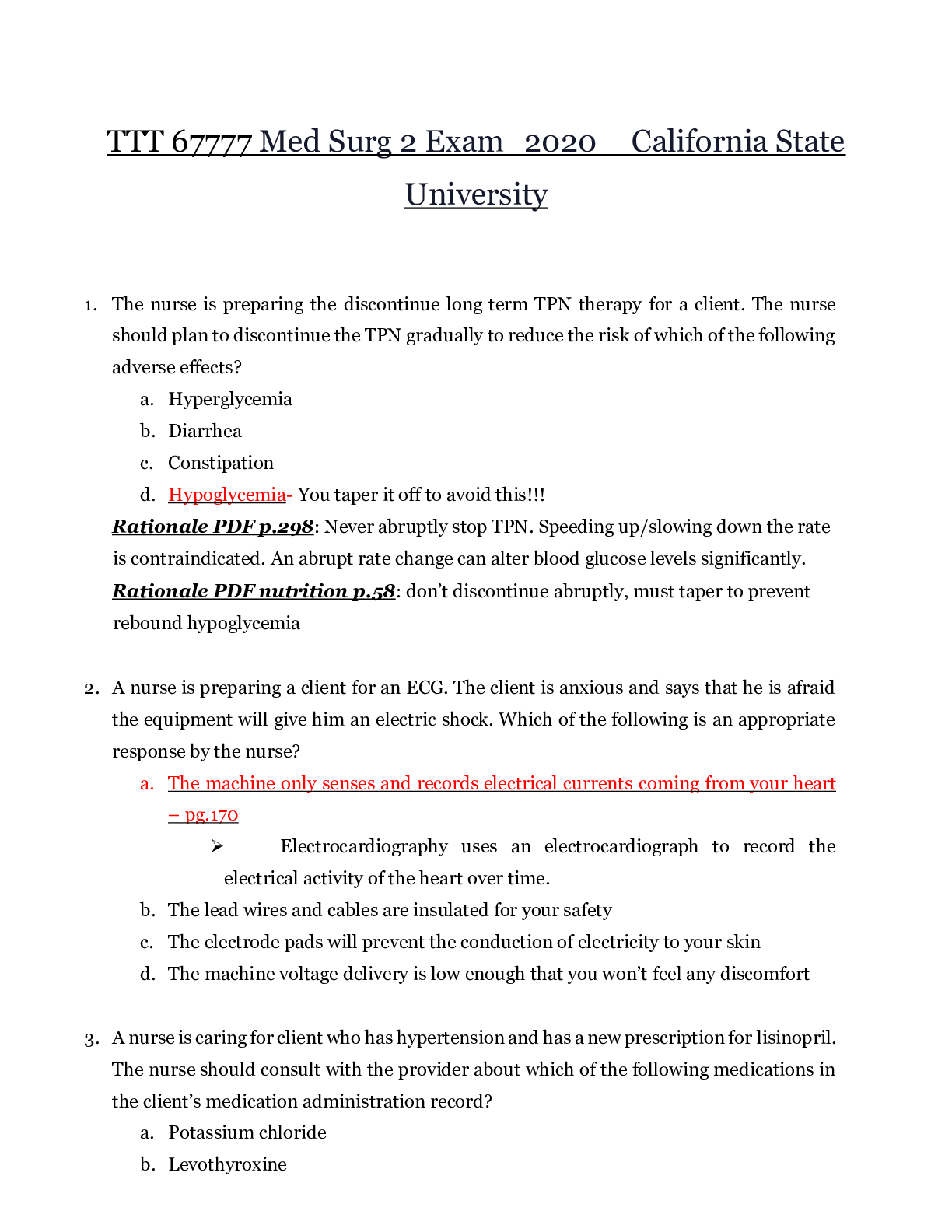
 – Chamberlain College of Nursing.png)

